A SOUND SOLUTION
Norwood designs, manufactures and installs its innovative modular partitioning system for the new Ray Dolby Centre
HLM Architects takes a holistic approach to leisure provision in Wokingham
Historic space now offers vibrant new community hub for live events

November 2022 Issue 123 Public Sector Build Journal Leisure Housing Education Healthcare psbjmagazine.com
What employers can do to help their employees tackle cost-of-living crisis
Introducing

Harnessing the power of natural cork, SprayCork wall & roof coatings are an innovative and eco-friendly solution for new build and retrofit public sector buildings.

Cork is one of the world’s most sustainable natural resources with a negative carbon footprint. No trees are felled during its harvest - in fact the bark grows back each time, absorbing much more carbon dioxide than usual, making it a powerful ally against climate change.

It is a strong thermal insulator reducing the dependence on heating systems, which also helps reduce condensation and black spot mould. It has sound dampening properties to improve acoustic comfort, whilst offering natural resistance to fire and high temperatures. Added to this, as it is hypoallegenic it helps to improve air quality against airbourne particles.

02 25 Year Warranty
For more information about using cork on your project, or to book a CPD, please contact our team: www.corksoluk.com | 01484 442420 | info@corksoluk.com
Better for you. Better for the planet.
SprayCork. The Ultimate Building Coating.
Applications: > Mould reduction in social housing > Safe encapsulation of asbestos > Refurbishment of all types of buildings > Fire protection up to 18m
Welcome to the November issue of PSBJ...
As the nation braces itself for a financially-crippling winter amid soaring energy costs and

linked to everyday items, it’s understandable that employees across a wide range of industries have cause for concern over the coming months – construction sector workers being no exception.
In a bid to help alleviate the financial pressures that some employees might be under, law firm Womble Bond Dickinson has shared with PSBJ a range of solutions that construction companies could action to help their workforce tackle the cost-of-living crisis. Whether implemented company-wide, or to those most in need, employers could reap long-term benefits as well, for instance, improved mental wellbeing thus reducing worker absences, and increased staff retention. Turn to page 14 to find out more.
It’s not just individuals feeling the pinch in this current economic climate. The public sector itself is having to manage its budgets very cautiously, which is why preventing significant remedial work to its estate is of the utmost importance. Schools, in particular, are a ticking timebomb for financial outlay, but by adopting a regular maintenance plan, you can very easily prevent minor issues becoming major ones. In this edition, we hear from Ian Dryden of SIG D&T who discusses the importance of a planned, proactive roof maintenance strategy. Head over to page 28 to learn more.
Elsewhere in this issue, Morley Glass explains why integral blinds tick all the boxes for healthcare buildings, HLM showcases the exceptional delivery of a new sustainable leisure centre and library in the heart of Wokingham and ROCKWOOL details how to evaluate the different insulation options available using the data provided by manufacturers.
I hope you enjoy this issue. Don’t forget, you can also access the magazine’s features, product news and supplier information on PSBJ’s user-friendly and engaging website. Fully responsive, the website allows you to read all the latest stories on-the-go either on your phone or tablet. Simply visit www.psbjmagazine.com.

03
•
us on Social Media: Hannah
are invited and when not accepted will be returned only if accompanied by a fully stamped and return addressed envelope. No responsibility will be
for drawings, photographs or literary contributions during transmission or
the editor's hands.
the absence
an agreement the copyright
contributions, literary, photographics or artistic belongs
Media Ltd. The Publisher accepts no responsibility
of advertisements appearing
the magazine and the opinions expressed
editorial material or otherwise do not necessarily represent
publisher. The Publisher does not accept any liability
any loss
late appearance or non publication
advertisement. Editor Hannah Woodger hannah@redhutmedia.com Rebecca Kemp rebecca@redhutmedia.com Print & Digital Advertising Sam Ball sam@redhutmedia.com Jim Moore jim@redhutmedia.com Print Design Manager Jack Witcomb jack@redhutmedia.com Digital Design Manager Matt Morse matt@redhutmedia.com Accounts Rachel Pike accounts@redhutmedia.com Sales Support & Statistics Klare Ball klare@redhutmedia.com Publisher Sam Ball sam@redhutmedia.com Published by Red Hut Media Ltd. 5 Mansion Row, Brompton, Kent, ME7 5SE psbjmagazine.com 01622 946150 redhutmedia.com PSBJ is a proud supporter of the Chartered Institute of Architectural Technologists. WELCOME NOTE @psbjmagazine
Designed in Revit by nbbj and delivered in BIM by Bouygues UK, with specialist modular partitioning designed, manufactured and installed by Norwood, the new Ray Dolby Centre for research and collaboration will form part of Cambridge University’s physics department. See page 20. Hannah Woodger • Editor
hannah@redhutmedia.com Find
Contributions
taken
in
In
of
of all
to Red Hut
in respect
in
in
the view of the
of
arising from the
of any
inflation
06 News
A round up of the latest industry news, including charity events, awarded contracts, completed projects and much more.
08 Upfront
A once-derelict potato market in the county town of Carlow in Ireland has undergone a thoughtful regeneration to create a modern, vibrant and flexible community space.

12 Leisure
HLM Architects has delivered a modern, sustainable leisure centre and library in the heart of Wokingham, breathing new life into an unloved and out-of-date site.
14 Legal & Business
Daisy Watson at Womble Bond Dickinson offers some practical steps that employers in the construction sector can take to help their employees tackle the financial squeeze.
16 Healthcare
Ian Short, Managing Director of Morley Glass, explains why integral blinds provide the ideal shading and privacy solution for hospitals and other health and social care environments.

08
18 Paints, Coatings & Finishes
With its winning combination of longlasting protection, ease of application and sustainability, galvanizing is the finish of choice for many industries across the globe.
22 Fire Safety
Sapphire Balconies discusses the role of offsite-built balcony systems amid the tightening of Building Regulations in the wake of the Grenfell Tower tragedy.
24 Education
20 Floors, Walls & Ceilings
At Cambridge University, the Ray Dolby Centre has specified the use of specialist modular partitioning designed, manufactured and installed by Norwood.
A premium, high performance full fill insulation board.

With precision cut tongue and groove joints on all four sides, you can be ensured tight locking insulation which minimises heat loss through thermal bridging. This unique feature also means greater ease and speed of installation – Now that’s joined up thinking.
A new special provision £10m academy in Middlesbrough, which will accommodate over 100 primary-age pupils, has finally opened its doors after getting the green light five years ago. www.recticelinsulation.co.uk
04 CONTENTS
Easy-fit, tongue and groove insulation for warmer homes and minimal thermal idging
26
26 Housing
The correct specification of paints, coatings and colour can support the sustainability and safety of dwellings – and even improve occupant wellbeing. Dulux Trade takes a closer look.


28 Roofing, Cladding & Insulation

Without an effective roof maintenance plan, minor issues can soon become major issues. Ian Dryden outlines how SIG D&T is working with schools to prioritise roof maintenance issues.
30 Talking Point
David Churchill, Partner at Carter Jonas (London), considers what needs to be done to encourage new garden communities, in order to meet required housing targets.
32 Technical Focus
Paul Barrett, Head of Product Management at ROCKWOOL UK, explains how to evaluate different insulation options using the data provided by manufacturers.

28
34 London Build Preview
Offering a totally unique experience, London Build – one of the UK’s leading construction shows – returns to Olympia London’s Grand Hall from 16 to 17th November.
36 Product Showcase
A dedicated focus of industry news, products and case studies to help specifiers and local authorities make informed decisions.
05 CONTENTS
The first phase of a new development designed to alleviate some of the pressure on Leicester’s social housing system has been granted approval by the city’s planning department. The Lanesborough Road scheme in Rushey Mead will feature a total of 37 dwellings designed by award-winning architecture practice CPMG Architects, with a range of two- to four-bedroom family homes and one- to two-bedroom apartments. A further 24 dwellings are planned for a second phase of the development. With Leicester City Council experiencing a near 6000-person waiting list for social housing, this latest development is set to regenerate a 1.4-hectare area of the city suburb with a mix of housing types in keeping with the council’s Core Strategic Policy. All dwellings are also designed for enhanced accessibility, with one bungalow featuring a design specifically tailored for residents who are wheelchair users. The designs for the homes have been drawn up with the city’s ambitious sustainability goals in mind, featuring air-source heat pumps, solar panels and a fabric-first approach, which help the development significantly exceed the requirements of standard Building Regulations by more than 80%.

Planning approved for new primary school in Irvine

A milestone has been reached on the new primary school at Montgomerie Park, Irvine, which will be built to Passivhaus standards after receiving planning approval through North Ayrshire Council. The new primary school will comprise 12 classrooms, early learning facilities, a gymnasium incorporating flexible performance areas, dining facilities and outdoor learning spaces including a seven-a-side all-weather pitch. hub South West Scotland appointed Robertson Construction Central West as its Tier 1 delivery partner for this project on behalf of North Ayrshire Council. Partly funded as part of the £2bn Learning Estate Investment Programme (LEIP), which focuses on delivering high-quality, low-carbon and digitally-enabled learning environments, the new school will support sustainable and inclusive economic growth. Designed by JM Architects, the facility will benefit from extensive landscaping and will support the recent housing development at Montgomerie Park Irvine. The new school has been designed with end-user requirements and sustainability as key priorities and will be the first Passivhaus school in the council’s education portfolio.
North-West-based Beesley & Fildes, the family-owned independent builder’s merchant, has invested £1.2m in its timber milling facility in Widnes in response to increased demand for both timber stock items across the company’s branch network and bespoke orders. The timber mill, acquired by Beesley & Fildes in 2004, produces the skirting, architraves, flooring, planed timber, door casings and certified fire-door casing kits sold across the company’s 11-branch network and online. The investment includes two new Weinig planing and profiling lines, which will replace the mill’s existing planing equipment, enabling increased throughput, fast set-up and a consistently-excellent finish at the Beesley & Fildes timber mill. Also included in the new investment programme is a new, British-made, fully-automated Stenner re-saw that will convert timber for the production of skirting boards, fence panels and feather-edged boarding. From cross-cutting machine manufacturer, Stromab, Beelsey & Fildes has bought an automated cross-cutting machine that will enhance the range of door casing and certified fire-door casing sets the company can offer across its branch network. Investment in all machines has been coordinated with an upgrade to the mill’s extraction system and tool room, ensuring the facility provides a safe, comfortable and digital-enabled work environment that will future-proof Beesley & Fildes’ timber milling capabilities.
Morton Fraser, one of the largest independent law firms in Scotland, has been named as a supplier on Crown Commercial Service’s Public Sector Legal Services framework, following a competitive tender process. While Morton Fraser was appointed to the previous CCS Framework in 2018, this new framework puts a stronger emphasis on social value, aligning strongly with the firm’s own culture. Through the framework, the firm will collaborate with clients on objectives, such as tackling inequality and improving diversity, making gender balance improvements, and supporting improvements for under-represented groups. Jenny Dickson, Chair and Head of the Public Sector Team at Morton Fraser, said: “From continued pandemic recovery to rising inflation and the cost-of-living crisis, the pressure being faced by the public sector has potentially never been greater. In this current climate, making progress towards improving diversity, inclusion and equality is particularly important, and our team is proud to have the opportunity to work with the public sector organisations on the framework at such a pivotal time.” Morton Fraser has been appointed to the following lots on the Framework: Lot 1b – Full Service Provision – Scotland and Lot 2b – General Service Provision – Scotland.
06
INDUSTRY UPDATES Each month PSBJ rounds up the latest public sector construction updates, from new contracts to industry awards. Green light for significant Rushey Mead social housing development
Beesley & Fildes invests £1.2m in timber mill upgrade NEWS
Morton Fraser wins CCS Public Sector Legal Services framework appointment
London-based architecture practice Penoyre & Prasad, a studio of Perkins&Will, has designed a new 420-pupil primary school in Sugar House Island, East London. The new school will support the unique curriculum of the education provider, the Big Education Trust, and is sister to the Ofsted-rated ‘Outstanding’ School 21, in nearby Stratford. The building has been designed specifically to support the school’s unique curriculum based on the three pillars of head, heart and hand: developing the head to provide rich knowledge and deep understanding; the heart to focus on wellbeing and relationships; and the hand to encourage every child to learn about creativity, problem-solving and the arts. The school offers students a variety of learning experiences and includes a range of spaces, such as a ‘Makerspace’ dedicated to arts, crafts and technology; ‘Oracy Stairs’ on each floor, which offer informal seating and teaching space; and a flexible studio that has been designed for dance, sport and performances. The school also boasts a dedicated room to cater to students with special educational needs (SEN). With floor space of 2413m2 , and spanning over three storeys, the building sits on a highlycomplex, restricted urban site. The scheme is designed within a rectangular footprint as efficiently as possible, remaining respectful to its sensitive setting.


Work has completed on Abbey Farm Educate Together Primary School in north Swindon. The school was delivered by vertically-integrated offsite construction specialist Reds10. Reds10 was appointed by the Department for Education (DfE) as principal contractor to design and build the school, which is part of the DfE’s four-year £3bn ‘Offsite Schools Framework’ and will be run by the Educate Together Academy Trust. The school is set on a 4.6-acre site and is part of a wider residential-led, mixed-use development by Redrow. One of the standout achievements of the project is that the building was designed as net-zero carbon in operation ahead of the DfE’s sustainability Output Specification (S21) official launch. S21 was introduced under the new construction framework in November 2021, calling for all new school buildings in England to reach net-zero operational carbon. The building, which is net-zero carbon in design, includes enhanced sustainability features such as air-source heat pumps and photovoltaics, both mechanical and natural ventilation to maintain excellent internal air quality, aluminium door and window frames made from recycled materials, GIFA floorboards with 50% recycled content and timber cladding, which is inherently lower in embodied carbon.
Anticipation is building for Nottingham City Council’s new Central Library, which sits at the heart of the Broad Marsh regeneration area, as work is now underway on the interior fitout and refurbishment with specialist Overbury. A new Central Library is one of the key elements of the regeneration of the city’s Southside area and will be surrounded by transformed streets, with pedestrianisation, planting, seating and plans for a new plaza to link through the demolished section of the former shopping centre to Lister Gate and the city centre beyond. The library, which is part of the new Broad Marsh Car Park and Bus Station complex, will be Overbury’s first major project to be procured through SCAPE – one of the UK’s leading public sector procurement authorities – which has been made possible via its sister company Morgan Sindall Construction. The new library will feature a high-quality children’s library with an immersive storytelling room, extensive book collection and comfortable areas to sit and read. Other amenities will include a cafe and ground-floor reception area, which can be converted into a performance space, a learning lab for special activities and school class visits, meeting rooms, exhibition space and creative design areas.
United Living Group, the provider of infrastructure, housing and property services, is pleased to announce it has completed a dual project on the Hatfield Close and Gerrard House tower blocks in Lewisham. The project has seen its pre-existing combustible cladding, replaced it with non-combustible A1 fire-rated material, and carried out in-depth fire safety and improvement works. The project represented over £22m of investment in the 151 homes and the surrounding area across the three 13-storey tower blocks, with circa £16m in funding from the Government building safety budget – ‘Remediation of non-ACM buildings’. United Living Group was commissioned by Lewisham Homes to deliver the Hatfield Close and Gerrard House fire safety transformation project, undertaking emergency works starting in October 2017. The new cladding is designed to be highly fire resistant with the tiles made from terracotta and have an A1 safety rating, the highest achievable. The supports and insulation behind the cladding have also been given an A1 rating. Additional works included the installation of smoke detectors, sprinkler systems, automatic opening vents, upgraded windows, new doors, balconies and structural works.
07
Penoyre & Prasad designs innovative new primary school
Abbey Farm Educate Together Primary School completed on the DfE’s Offsite Schools Framework
NEWS
Overbury to transform Nottingham’s new Central Library United Living Group announces the completion of fire safety and improvement project in Lewisham
NEW COMMUNITY SPACE LEVELS UP COUNTY TOWN OF CARLOW
From farmers’ markets through to musical concerts and artistic displays, Carlow Exhange is the brainchild of a forwardthinking council, which was committed to ensuring the revival of this historic space that now offers a multi-purpose venue for an array of community events.
A
once-derelict potato market in the heart of the county town of Carlow in Ireland has undergone a thoughtful regeneration to create a modern, vibrant and flexible community space.
Operating as a potato market for the local area until the 1930s, it was also home to an open-air livestock market, a cobbler’s shop, a garage and a factory, before it fell into disuse in the latter part of the 20th century.
Proposals in the early 2000s for its commercial development were put on indefinite hold until Carlow County Council spearheaded the revival of this unique facility.
A new public realm for indoor and outdoor events
The project brief for Carlow Exchange was to provide a new covered outdoor space suitable for multiple uses including the Carlow Farmers’ Market, exhibitions, concerts and events. This development is part of a wider ambition to level up the Carlow area, which has suffered from a number of derelict

buildings and has lacked a focused civic centre that serves its residents.
“Carlow Exchange is located on grounds of significant historical and cultural importance,” explains Conor Moriarty, Senior Executive Architect at Carlow County Council.
“The site cried out for redevelopment to become once more the hub of its glory days, albeit one for modern-day requirements, such as artistic displays, concerts, exhibitions and events. Graphisoft’s Archicad was instrumental in the design and implementation of this redevelopment project.”
The main objective for this redevelopment was to greatly improve space functionality, as Conor explains: “The venue will be available to any group gatherings for the community. The space is a covered shell with a wide-open space, and it offers flexibility through its modular design. This means that events can still go ahead even in inclement weather, and the space can be adapted to suit various activities. I believe this is a wonderful reincarnation of the ancient potato market of the 1700s.”
Real-time visualisations bring project to life
Conor had previous experience with Graphisoft software, and on this occasion, he found that a mix of Archicad, Twinmotion and BIMx offered great results, helping to foster effective collaboration between project partners.
Thanks to the live connection, Archicad and Twinmotion are synchronised in realtime; all changes made in the Archicad model are subject to an automated update process inside Twinmotion. This enables users to edit the Archicad model and make fast design decisions, while all changes made in the Archicad model are subject to an automated update process inside Twinmotion. The link accelerates 3D design and visualisation workflows for projects with multiple stakeholders.
Demonstrating design ideas to the public
BIMx was also extensively used for presentations to public representatives and for discussing details with the design team. A particularly useful feature was
UPFRONT
08
Images: ©Carlow County Council
the ability to show members of the public the lighting conditions and options with a great degree of accuracy. BIMx allowed the architects to put 15 different crosssections in context in the 3D model, which made them significantly more legible.
As an added benefit, BIMx features the ‘BIM Hyper-model’ – a game-like navigation tool that helps anyone explore the building model and understand project deliverables. The real-time model cut-throughs, in-context measuring and project markups in the model context helped the design team to easily communicate their ideas to the nonspecialist stakeholders.
Shining new light on historic building
The building is unique in its use of materials and the roof is its most striking element, with its illumination at night a key part of its material palette. The roof, supported by a new steel structure, is lifted off the original walls and doesn’t touch them, but rather frames the historic layers of the building.
The task of providing natural light into the space was achieved by providing several overlapping roof elements with clerestory windows, as well as a gap between the new roof and old walls that allows light in. The building
will
Careful collaboration ensures coordinated design
As with all projects of this size and importance for the local community, Carlow Exchange presented a unique set of challenges. These came in the form of early issues and clashes with the structural design, but by being able to import the steelwork model directly into the Archicad model for reference, the team could spot all potential errors early on.
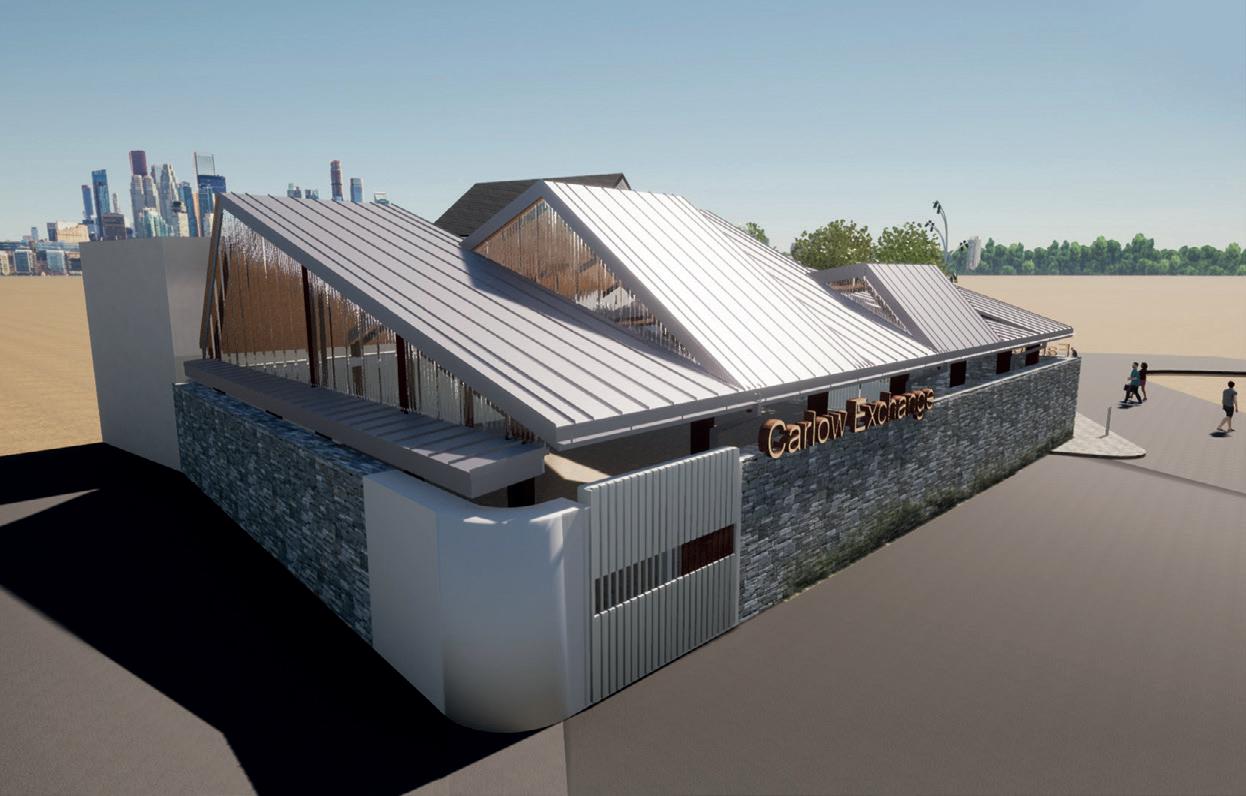

09 UPFRONT
be lit up with a combination of artificial lighting and distinctive threedimensional signage.
“An external structural engineering company was involved in the steelwork, and the IFC import feature enabled them to create their own model, which we then imported straight into the Archicad model for accuracy,” says Conor. “We then carried out a clash detection study to make sure it all coordinated. We also used a live link that allowed us to update the model and share it with other members of the team, irrespective of their location.”
“Archicad is a great tool for finding conflicts within the model for early identification of potential mistakes,” explains Conor. “There were early issues with the structural proposal when it was originally designed, but thanks to Archicad we could see straight away where these issues were. This gave us the inspiration and the instruments we needed in order to make changes. This not only saved time on reworking the designs, but also avoided costly mistakes on site. This is particularly important when dealing with public sector works, which are always under intense public scrutiny and where we need to demonstrate value for money at all stages.”
A striking new venue for the whole community


Carlow Exchange was the first step in the larger civic redevelopment of the towncentre public realm, and it is expected to be completed and open to the public within months. As it was developed during the changing world of COVID, it proved to be very fortunate in terms of its timing. With an increased demand for outdoor and openplan spaces that allow for social distancing, Carlow Exchange was a pivotal project and is part of an overall bigger strategy. Now, the people of Carlow have a venue that allows them to come together and enjoy what the local area has to offer.

10
www.graphisoft.com/uk
UPFRONT

11
A HOLISTIC APPROACH TO LEISURE PROVISION

HLM Architects was commissioned to design the new Wokingham Leisure Centre by Wokingham Borough Council’s Property & Estates Department, with Pellikaan Construction appointed to undertake the build.
The new flagship state-of-the-art centre, which opened to the public in July, forms part of the vibrant, multi-millionpound Carnival Hub community complex in central Wokingham, a major part of the second and final phase of the Wokingham town-centre regeneration vision to adapt to the changing needs of residents and visitors.

Delivery of the new centre totalled approximately £19m, to be partly subsidised by the construction of the
adjacent residential development comprising 55 new homes as part of the overall mixed-use regeneration project.
The new leisure centre offers an appealing, light and airy space that is accessible to all. Connecting the Carnival Hub in the south with the new Elms Field development and the high street in the north, this ambitious scheme transformed previously-neglected and unused areas into thriving, new spaces in the town centre.
Breathing new life into an unloved site
The new leisure centre is located on the site of a previous 1990s building that was ageing, in need of significant repairs and provided minimal facilities beyond those of the pool hall.
Following many years of consultation with the local community, it was clear that people wanted a modern complex with a variety of uses beyond those of a swimming pool and fitness hall. HLM’s design went even further, with the new facility providing a large pools hall with a 25m four-lane swimming pool, a learner pool and a wet-play area with fountains and water jets, all with views from the cafe and a first-floor viewing gallery. Designed in line with Sport England standards, the pools represent a transformational upgrade for both the local community and Wokingham’s swimming training and competition facilities.
There is a large gym for 150 users, spin studio, multi-use studios, a spa, health and wellbeing centre with a ‘Live Well’ gym that caters to long-term rehabilitation requirements. The four-court sports hall can also be used for a variety of cultural events, such as performances or lectures, with raked seating for up to 400 people, modular stage and lighting and audio-visual rigs.
Wokingham Leisure Centre is co-located with a new library to replace the former facility. This encourages multiple community uses within one modern hub, integrating the two spaces in a seamless way. The renewed design has also facilitated vastly-improved disabled access for both the leisure centre and the library. This includes a higher number of blue badge parking spaces, better accessible changing and showering facilities, accessible pool with steps, pool lift and
12
LEISURE
hoists, and provision of a Changing Places facility. Additionally, the new library is now all on one level, having previously been split across two floors with narrow corridors and sloped access up to the main entrance.
A modern library to align with evolving needs Wokingham’s former central library was located in an old building, creating a pressing need for a modern new library provision. By co-locating it with the leisure centre, the revamped library benefited from moving to a new, purpose-built space enhanced with the latest in technology and sustainability advancements. Not only does this position the library as a new go-to destination to spend time in, but it also creates a mutually beneficial relationship with the leisure centre that will hopefully drive increased footfall to both.
In undertaking the design, HLM recognised that the way in which people use libraries has changed considerably, and so the new space needed to be versatile enough to be futureproofed for years to come. A range of seating options keeps the space flexible enough to cater for a variety of users, while bulkier bookshelves include integrated signage and space to display artwork.
A different colour scheme gives clear and independent identities to the children and adult sections without the use of partitions. The children’s area is infused with a playful, bright ‘carnival’ of colours, while a more mature palette was selected for the teen and adult area. An adjacent courtyard provides space for active learning and Technology Enhanced Active Learning (TEAL).
The design also includes space for the central libraries to operate from, having good access and making the most of the central location.
One of the UK’s most energyefficient leisure centres
In response to the climate emergency, Wokingham Borough Council put in place a Climate Emergency Action Plan (CEAP), with the objective of reaching net carbon zero by 2030. The project team worked closely with the council to support its sustainability goals and reduce carbon emissions as much as possible throughout, resulting in Wokingham becoming one of the UK’s most energyefficient leisure centres.
As the Carnival Hub tender had already been issued, HLM’s design team – which was also retained as technical advisors to the council – worked with Pellikaan to revise and adapt the design in line with the council’s CEAP. HLM sought to reach the highest environmental standards, maximising energy efficiency and lowering operating costs as much as possible. Additional revisions included new airsource heat pumps and solar panels, achieving vastly-improved performance across the site, which has achieved massive carbon reductions of 117%, thereby surpassing Government targets. Further, careful consideration was given to improving fabric performance and insulation, thermal performance and airtightness standards, as well as reducing the volumes of high-energy demand spaces. The team also focused its efforts on the specification of energyefficient plant and the use of sustainable technologies to help lower carbon both during construction and operationally once the building is in use. Elsewhere, sustainable drainage systems, including swales, rain gardens and permeable paving, have been incorporated to provide effective surface water drainage.
Inspired by nature
HLM’s interior design strategy centred around the themes of biophilia, wellbeing and the different levels of intensity experienced during physical exercise. The interior creates a sense of cohesion and ease of navigation for users, with each space flowing effortlessly to the next, unified through consistent colour palettes, natural textures and materials throughout.
The cafe offers expansive views, while other spacious, glazed areas create a lightfilled space that also helps to join up the interior with the surrounding landscaping and allows visitors to feel a connection with nature.


The surrounding landscape, meanwhile, has been designed to provide a high-quality public realm, striking a good balance between public and private spaces and ensuring the leisure centre and neighbouring residential block are well integrated.
A wide variety of social spaces along the central promenade inspire social interaction, with new lighting throughout the landscape creating a welcoming, safe and appealing environment during both day and night hours. A key design feature is the rain gardens that line the promenade, promoting sustainability whilst providing beautiful and seasonal planting. These have been designed with gravel mulch and larger glacial boulders, which has resulted in an attractive riverbed aesthetic.
The new leisure centre, library and the entire surrounding development are a great step forward in regenerating the local area and creating a focal point for residents and visitors to enjoy for many years to come.
13 www.hlmarchitects.com LEISURE
HOW EMPLOYERS CAN SUPPORT CONSTRUCTION WORKERS WITH THE COST-OF-LIVING CRISIS

The cost-of-living crisis continues to impact on family budgets, causing many employees concern as to how they will pay their bills. At the same time, labour shortages are hitting the construction industry, with recruitment and retention a priority for employers to overcome this challenge.
ere, Daisy Watson, Solicitor at Womble Bond Dickinson, offers some practical steps that employers in the construction sector can take to help their employees tackle the financial squeeze:

Employee benefits
Many employers have extensive benefits packages, which could save employees money and give them peace of mind.
Here are some examples of what effective benefits packages might include: Financial wellbeing support from an external provider
Travel discount schemes
Private health and dental cover
Permanent health insurance
Promoting the Government’s Tax-Free Childcare scheme
Discount schemes, which typically include discounts for retail, leisure, holidays and gym membership.
Training
Financial and mental wellbeing are interlinked – an employee concerned about their finances is likely to feel
stressed. This could affect their performance at work and even lead to physical illness.
Financial wellbeing training is becoming more common. Its purpose is to empower employees to utilise the benefits and services offered to them and to give them practical tips on managing personal finances (including budgeting).
Lump-sum cash payments
Offering a lump-sum cash payment to employees can assist in reducing the pressure on employees feeling the squeeze during the current climate, but this will not be financially viable for all employers.
Employers that want to explore this route to help their employees, but cannot offer widespread lump-sum payments, could consider targeting staff who are most in need. However, this may raise further issues, such as who needs the most help, how much to give and will it be treated as a loan or a grant? It could also lead to dissatisfaction among
employees who are not offered a cash payment, particularly if there is any suspicion of discrimination.
Pay rises
Pay rises are an obvious way of helping with the cost of living, but not every employer, facing their own challenges with increased costs, will be able or willing to provide substantial pay rises. In addition, the Bank of England has warned that offering pay rises will simply lead to further inflation, which, in turn, will accelerate the cost-of-living crisis.
Employers may also decide to carry out a pay audit to ensure they are paying the current market rate. This not only provides employees with the satisfaction that they are being appropriately remunerated, but also helps employers identify those pockets where pay could be increased.
Loans
Many employers already offer loans to their employees (e.g., for travel season tickets), so offering hardship loans to
employees would simply be an extension of this and an option for employers to consider as a way of helping their employees. Employers need to remain mindful of the fact that if the amount of the loan is greater than £10,000, then the loan becomes taxable.
If employers decided to start offering interestfree loans to employees, they would need to seek appropriate legal and tax advice. They would also need to ensure a suitable loan agreement was put in place and that there were appropriate clauses in contracts of employment stating that the employer has the right to make deductions from an employee’s salary for the repayment of an outstanding loan on termination of employment.
Conclusion
The cost-of-living crisis shows no signs of disappearing. There are many ways in which employers can help employees – not all of which have a cost attached – and providing support may just help with recruitment and retention issues as well.
14
dickinson.com/uk
www.womblebond
LEGAL & BUSINESS
Daisy
Watson
qualified
as a Solicitor in September 2019 and specialises in employment law. She advises employers on a wide range of contentious and noncontentious employment law matters, including performance management, absence management, defending tribunal claims, redundancy procedures and settlement agreements.
H
Tested to 0.74 kN with fixings at 600 mm centres (all competitors are generally 200/250 mm) meaning you only need a third of the fixings saving you a lot of time and money


Tested to 1.5kN with fixings at 400mm centres (all competitors are generally 200/250 mm) so again you need half as many fixings saving you time and money
Tested to 1800 mm high with 21.52 mm Sentry and only deflects 18 mm at the top making it an ideal solution for privacy screens when you want the channel detail to remain the same


T +44 0161 804 9500 | F +44 0161 804 9505 sales@onlevel-uk.com | www.onlevel.com TL 6020 1.5
|
|
PVB Glass
CHESHIRE PLAINS, ENGLAND TRANS LEVEL FRAMELESS GLASS BALUSTRADE
kN TOP MOUNT
Fully adjustable from one side.
Only system in the UK which will meet 1.5 kN with 21.52 mm
|
|
|
WHY INTEGRAL BLINDS TICK ALL THE BOXES FOR HEALTHCARE BUILDINGS
With hygiene and longevity key specification priorities, Ian Short, Managing Director of Morley Glass, explains why integral blinds provide the ideal shading and privacy solution for hospitals and other health and social care environments.

ith natural light in buildings being at the core of what makes a building ‘healthy’, it is no surprise that modern healthcare environments are designed to maximise the availability of daylight and its flow throughout internal spaces.
But that has to be properly managed given the need for privacy at various times throughout the day, if not all day in certain cases. And steps have to be taken to ensure adequate shading is provided where required to prevent problems resulting from excessive sunlight, such as glare and overheating.
Whilst curtains manufactured using specialist fabrics and traditional wall, ceiling or window-frame-mounted blinds are typically regarded as the go-to options for providing shading and privacy in individual rooms, the benefits of integral blinds are increasingly being realised.
Integral blinds are Venetian or pleated blinds that sit between the panes of glass in double-glazed units. They are completely encapsulated throughout the window’s design life, making them particularly beneficial for health and social care environments.
Virtually zero cleaning required
The cavity inside a double-glazed unit is free from dirt, germs and dust, which means an integral blind will never become dirty and requires no cleaning of the main blind unit throughout its service life. All that is needed is routine cleaning of the touchpoint of the blind control, whether that is a slider device, knob or winder –and this can be coated in the ‘Sanitized’ antimicrobial coating to help with infection control on certain systems.
Operationally reliable with very limited risk of damage
Integral blinds are essentially a fit-andforget solution due to their limited cleaning and maintenance requirements, but they can also offer an extremely long service life with the right product specification.
Like any building element, different integral blind systems vary hugely in quality, so it is important to ensure that any proposed solution is built on sound mechanical systems. This is why Morley Glass exclusively partners with a world leader in integral blind technology, Pellini S.p.A., which manufactures ScreenLine systems.
Much like we are encouraged to think about the processor that is inside the laptop we choose, installing integral blinds built on ScreenLine systems represents the highest-quality choice. Remember, long-term value and lowest whole-life cost rarely stems from specifying the cheapest product.
Also consider that, as the blind units are protected by the glass, they are unlikely to be accidentally damaged unless the glass unit is broken. And, should any of the external control elements become damaged, with ScreenLine integral blind systems, they are very quick and easy to repair.
Outstanding aesthetics
Functionality is balanced with aesthetics very well with integral blinds. This helps integral blinds make a positive contribution to the creation of a sensitively-designed healthcare environment that looks clean, fresh and modern and supports care goals.
The systems available from Morley Glass give architects and specifiers a choice of Venetian integral blinds in 10 colours along with pleated blinds in 12
16 HEALTHCARE
W
colours. The control systems are also slimline and designed to be virtually unnoticeable. Headrails or sideguides, which feature in certain control systems, are minimal in their appearance to maximise light transmission and visibility through the window when the blind slats are open, or the blind is fully raised.
This makes integral blinds suitable for any space in the healthcare environment, from a consultation room or ward to a day room, waiting room or corridors.

Safe in the event of a fire Choosing integral blinds for a healthcare environment does not mean compromising on fire safety objectives. Morley Glass offers integral blinds in a specification that features fire-rated glass to offer protection in the event of a fire of 30, 60 or 120 minutes. These fire-rated integral blind units are fully certified to give complete peace of mind to specifiers, hospital managers and building users.
Easy and safe to operate with choice of control systems
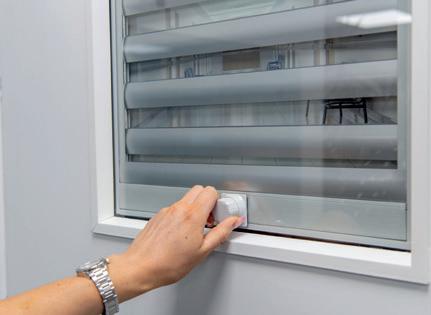
Integral blinds manufactured by Morley Glass are available in five different control systems. These range from an elegant and simple pull-cord system, the C System, which can also be operated by a turning knob, to cordless magnetic slider and motorised systems.
Each of these is designed with simplicity in mind, which makes raising, lowering and – in the case of Venetian blinds – tilting

of the slides something that staff and patients could do as required, subject to requirements. Visibility and privacy can, therefore, be easily adjusted according to factors such as changing sunlight levels and patient privacy needs.
An anti-ligature knob can also be specified with some systems to offer an extra level of safety in rooms used by vulnerable patients.
A solution designed
specifically for healthcare Whilst any of the Morley Glass integral blind systems can be used for healthcare environments, a new system has recently been developed specifically for this sector. Called ScreenView, this balances the need for patient privacy and observation by allowing very easy switching between the two at different times of the day.
ScreenView has two layers of wide slats arranged in a ladder style, which move up and down to provide an open view for observation or complete closure.
Its design is perfectly suited to door vision panels and other windows that separate a healthcare facility’s communal or public areas from private spaces. Unlike vision panel flaps and externally-mounted blinds, typically used in these applications, the ScreenView blind requires no cleaning or maintenance, other than routine cleaning of the control knob, which is protected with a ‘Sanitized’ antimicrobial coating.
www.morleyglass.co.uk
17
HEALTHCARE
GALVANIZING: THE SUSTAINABLE CHOICE

With its winning combination of long-lasting protection, ease of application and sustainability, galvanizing is the finish of choice for many industries across the globe including construction, manufacturing and agriculture.
y its very nature, the construction industry alone has a significant impact on the environment – accounting for 36% of worldwide energy usage and 40% of CO2 emissions*. It’s no surprise, therefore, that the introduction of evermore stringent environmental rules and regulations, as well as the high costs and ethical factors relating to industry, is seeing the increasing numbers of contractors, looking to adopt more environmentally-friendly processes, turning to galvanizing.
One organisation at the very forefront of the industry, which is helping those across a wealth of sectors become ‘greener’ is Wedge Group Galvanizing, one of the
largest hot-dip galvanizing organisations in the UK. Over the past 12 months alone, the team has worked on a diverse range of projects, including the refurbishment of one of the busiest heritage railways in the country, the creation of a centrepiece for the new Digital Aviation Research and Technology Centre (DARTeC) at Cranfield University, and the construction of an iconic housing development in central Mayfair.
As a true heavyweight in its field, Wedge Group Galvanizing’s Sales and Marketing Director, Andy Harrison, explains the galvanizing process step by step, what makes it such a sustainable option and why it is increasingly becoming adopted by UK industries.
“Hot-dip galvanizing is, essentially, the process of coating clean steel with a layer of molten zinc to protect the item from corrosion and provide a long-lasting, durable surface. It’s more robust than other coatings that only bond chemically or mechanically, and it has the added advantage of fully coating the steel. As a finish, it is not only highly effective, but is also extremely eco friendly. A single, oneoff treatment will coat a product both inside and out, providing a finish that can protect steel and keep it maintenance free for over 70 years, considerably more in the right conditions.

“This means that the whole-life costs of products protected by the hotdip galvanizing process can be significantly reduced because there is no need for the expense, down-time and inconvenience of repeated onsite maintenance or replacement.
“Not only does galvanizing lengthen the lifespan of steel, but it is highly energy efficient throughout its production and whole lifecycle. The galvanizing process uses minimal resources to ensure a relatively-low environmental burden. Zinc’s non-ferrous properties mean steel can easily be recycled after use or regalvanized or removed and reused elsewhere.”
As a company, Wedge Group Galvanizing is leading the way by introducing a number of highlyinnovative and sophisticated elements to reduce waste, promote better use of resources and improve energy efficiency. To improve both fuel efficiency and performance, all plants use the most innovative pulse-fired, high-velocity furnace systems, which provide high fuel efficiency, low heat loss, low emission levels and extends the life of the kettle.
Another example of how the company, and the wider industry, is cutting energy consumption is the re-use of ‘waste’ heat created from the furnaces used in the galvanizing process. All of its plants have been fitted with heat exchanger units that transfer the ‘waste’ heat generated back into the overall process for use within both the pre-flux and de-grease tanks. The company also has rainwater collection and harvesting systems, which recycle rainwater back into the galvanizing process.
With the ongoing efforts being made within the industry to ensure that practices and procedures are as environmentally friendly as possible, and with many subsequently adopting galvanizing as their finish of choice, it seems that, as a process, it is set to long remain a leader in the sustainability stakes.
www.wedge-galv.co.uk
Source: *https://www.iea.org/topics/energy-efficiency
18 PAINTS, COATINGS & FINISHES
B
THE



19 Our innovative A1 fire resistant dash protects and enhances architecture without compromise to style, value and lifespan. A1 Dash comprises of non-combustible components to achieve the highest possible European fire classification to the BS EN
standard. Contact our team on 01744 353 005 or info@k.systems
13501-1
A1 AND ONLY
NORWOOD’S MODULAR EXPERTISE PROVIDES A SOUND SOLUTION FOR THE RAY DOLBY CENTRE

A key aim for both higher education providers and the corporate world is to create opportunities for academia and research to work collaboratively with businesses. There are advantages for both sides of the equation. For universities, it means opportunities for students and researchers to work on real-world projects and connect with potential future employers; while for companies, it offers a chance to shape future skills and benefit from knowledgeable specialists.
The challenge to delivering this aim is in creating an infrastructure that supports such collaboration. For many universities, developing a physical space for research and study that also provides an environment for private sector engagement has become a priority.

At Cambridge University, a £250m development – the Ray Dolby Centre – has become the benchmark for such collaboration between education and business. Designed in Revit by nbbj and delivered in BIM by Bouygues UK, with specialist modular partitioning designed, manufactured and installed by Norwood, the new centre for research and collaboration will form part of Cambridge University’s physics department.
The development has been named after Ray Dolby, a PhD alumnus of Cambridge University, a former fellow of Pembroke College, an inventor and the founder of Dolby; the A/V company synonymous with sound recording. It has been co-funded by Dolby and seeks to continue his legacy of innovation by providing a world-leading facility for research projects that furthers
learning and underpins commercial product development.
Safety and transparency
A noticeable trend in the design and construction of research environments is the move to make research as visible as possible and connect projects with the outside world. This is a key principle of the Ray Dolby development, which has been designed to showcase the innovation that takes place within the building to visitors and inspire students from across the university. The facility is high tech, with cleanrooms and controlled environments where research activities and experiments can take place, but the atrium provides a viewing gallery with a 2.85m-high, fire-rated glazed wall providing both segregation and safety.
The fire-rated glazed wall was part of Norwood’s £1.9m package on the Ray Dolby Centre project, which also included a 2500m 2 walk-on ceiling, and design, manufacture and installation of a cleanroom partitioning system totalling 4080m 2. To provide the safety protection
required for the R&D areas, the glazed wall called upon the cleanroom partition specialist’s design expertise and UK manufacturing capabilities.
Alongside the goals of transparency and exemplary health and safety, the facility has also been designed to address any commercial sensitivities for the corporate projects under development in the labs and research areas. To this end, the glazing has been fitted with blackout blinds to enable any commercially-sensitive research projects to be protected.
Glazed partition
The fire-rated glazed wall was designed by the Norwood team and is the largest fire-rated glazed partition the company has ever created. The specification requirement was for 60-minute fire integrity and insulation to protect the atrium from fire and heat from any incidents within the cleanroom or lab areas, and to protect the research facilities from any fire and heat due to an incident in the publicly-accessible areas.
20 FLOORS, WALLS & CEILINGS
“The design process for the glazed wall not only needed to consider the safety performance criteria for the installation, but also aesthetics and buildability,” explains Josh Banister, Managing Director of Norwood. “The aesthetics are important because this is a showpiece development that will attract both students and commercial partners for the university. Buildability was essential across a wide range of considerations, including structural loading, safety on site during the construction phase and the logistics of getting such a huge glazed wall into and out of the building.
“Our expertise in designing modular systems, and our joined-up service across design, manufacture and installation, enabled us to overcome the buildability challenges of this aspect of the specification with a modular solution, while answering safety and aesthetic requirements.”
The 70m span of the glazed wall was manufactured in 2.85m-high panels and was independently tested by UKASaccredited fire safety services specialist, Warringtonfire, prior to installation by the Norwood team. With each glazed panel weighing 200kg, installation of the fire-rated glazed wall was meticulously orchestrated by Norwood.
Flexible solution
The 2500m2 walk-on ceiling designed and installed by Norwood as part of the project has a 100kg/1200mm2 load capacity to enable ease of maintenance for the complex building services required by the labs and cleanrooms below. The ceiling has been installed at two levels, 3.2 and 3.5m, to accommodate the varying services and fit-out specifications across the building.


Norwood was also responsible for design, manufacture and installation of a cleanroom partitioning system totalling 4080m 2. Flexibility was a key element of the specification for the facility to allow research spaces to be reconfigured for different projects over time, so Norwood’s Mediline fully-demountable modular cleanroom partitioning system was an ideal solution. The company tailored its standard 1000mm modular cleanroom partitioning system to meet the required 1200mm specification and provide the required acoustic and firesafety requirements.
Part of the design requirement for the project was the ability to reconfigure the internal space around the changing needs of the university and different research and commercial projects. To this end, the Norwood team also developed a bespoke T-bolt system to enable easier reconfiguration of the cleanroom layouts during the lifecycle of the building. The system enables shelves to be mounted quickly and easily above
or below the vision panel aligned to research teams’ requirements.
Jordan Taylor, Project Manager at Bouygues UK, commented: “Norwood has worked collaboratively with our team to design a bespoke solution for the exacting specification of this unique building. The solution the team has developed brings together the company’s tried-and-tested expertise in modular acoustic panelling systems for cleanroom and advanced engineering environments, with an agile approach to customised design and a focus on the purpose of the finished building.
“The fire-rated glazed walls are a showpiece element of the project and Norwood was able to offer a turnkey solution from concept to installation. With the walk-on ceiling now also complete and the cleanroom partitions well underway, Norwood is helping us to make good progress on the build and is contributing to the versatility of this innovative research facility.”
21
FLOORS, WALLS & CEILINGS www.norwood.co.uk
BALCONY SYSTEMS FACE UP TO HIGH-RISE FIRE SAFETY ROLE
The grim lesson of the horrendous fire that engulfed London’s Grenfell Tower on 14th June 2017 is that fire safety applies as much to the exteriors of multi-storey residential buildings as it does to the interiors.
The Grenfell fire killed 72 people as flames spread through the external cladding of the 24-storey building. The incident and the ensuing public outcry led to a significant tightening of Building Regulations with an outright ban on combustible cladding materials.
But this was not the only cause for concern in high-rise buildings. Before and after the Grenfell incident, a significant number of apartments in London and other parts of the United Kingdom were damaged – some quite severely – by fires accidentally started on balconies.
Despite frequent warnings from fire chiefs about balcony fires, these were often attributed to accidents with smoking or sparks from barbecues, which ignited nearby furnishings or other combustible materials.

While some incidents clearly stemmed from residents’ actions, questions were also raised about the design and choice of materials used in balconies.
Tall apartment buildings continue to mushroom in areas of heavy residential demand with balconies giving the high-rise lifestyle a welcome hint of the outdoors. Unsurprisingly, perhaps, balcony systems themselves came under the spotlight.
As a leading specialist in offsite-manufactured systems, Sapphire Balconies contributes extensively to the post-Grenfell debate on fire safety. For example, Andrew Parsons, Sapphire’s Founder, helped to write BS 8579, the benchmark for balcony design throughout the United Kingdom.

In addition to advocating use of fire-safe materials, Sapphire has recommended that balconies should incorporate Class A non-perforate soffits, even before Grenfell. Soffits not only have the aesthetic benefit of screening support arms and drainage systems from view, but have shown in many balcony incidents that the use of them has helped to inhibit the external vertical spread of fire by deflecting flames and heat. Soffits also restrict the flow of oxygen and contain embers if items on a balcony are burning. This has now been recognised and added in to Part B regulations in their June 2022 amendments.
Sapphire’s Cassette balcony system uses steel support arms that are bolted to castin anchors. A thermal break is usually incorporated to minimise cold bridging. However, with the move to thinner slabs and minimal floor finishes, there is less space for traditional linear cavity barriers to pass over or under the balcony support stubs. Sapphire set out to solve the industry problem of ad hoc and often-untested site-assembled, fire-stopping solutions. Its own solution –the Sapphire StubGuard – has had numerous third-party independent testing. StubGuard is already available for use, subject to fire engineers’ and any project-specific approvals.
Sapphire says there is a valid case for overturning the ban on laminate glass, which, under the combustible cladding ban, is ‘effectively outlawed’ in facades over 11m in height, when it was not mentioned on the exemption list. In the whitepaper Sapphire
wrote for the UK Government, Nick Haughton, Head of Marketing – UK & Global at Sapphire, contends that laminate glass for balcony balustrades is not a fire – or general – safety risk but, in fact, a safety benefit.
It says, prior to the ban, laminate glass was widely preferred over metal railings – especially at height where its screening creates a more comfortable environment for users, as well as protecting furniture and plants. The possibility of obscure interlayers means laminate glass can also provide privacy, while still allowing light into the apartment.
As a prominent housing association discovered after specifying metal railings for its balconies to reduce fire risk, residents installed makeshift
windbreaks with plywood sheets and other material cable tied to the railings – an aesthetically-poor and much more hazardous solution.
Sapphire says although many industry leaders feel the ban on laminate glass was inadvertent, it also feels that the benefits of laminate glass far outweigh the reasons for the ban.
It says: “Thankfully, the Department of Levelling Up Housing and Communities has now started to relook at the new regulation and its overall impact on building safety.
“We recommend that clients and all professionals research the current situation, and fire safety generally, when specifying balconies.”
22
SAFETY OFFSITE-BUILT
FIRE
www.balconies.global
As important as the door
























23
Closing the last major thermal break.
REDUCES THE ENERGY
WALLS
This innovative product range represents
energy-e
Schöck Sconnex® relies on tried and tested technology, reduces vertical thermal bridges and
creates aesthetic and economic advantages. www.schoeck.com/en-gb/sconnex 220214_Anz_Sconnex_Editorial running_185x131_GB_rz3.indd 1 ZERO SEAL SYSTEMS LTD: 01785 282910 FIND OUT MORE AT: WWW.ZEROPLUS.CO.UK
DOOR
Sconnex®
SCONNEX®
LOSS AT
AND COLUMNS.
a breakthrough to a previously unsolved problem in
cient construction.
at the same time
FIRE
HARDWARE
hardware
Seals Hinges Locks Euro Cylinders Lever Handles Door Closers Letter Plates Door Stays Vision Frames Louvres Door Viewers Flush Bolts Panic & Emergency Exit Hardware
A fire door is an essential part of a building’s passive fire protection system. A critical component of every fire door is the hardware on it. At ZEROplus we have been independently fire testing door
for over 20 years, to be able today to offer an extensive range of tested products.
NEW £10M SPECIAL ACADEMY OPENS ITS DOORS FOR THE NEW ACADEMIC YEAR
A new special provision £10m academy in Middlesbrough, which will accommodate over 100 primary-age pupils, finally opened its doors in September after getting the green light five years ago.
Developed on behalf of the Department for Education (DfE), the Discovery Special Academy will cater for pupils with severe learning difficulties, including those with a physical disability, multi-sensory impairments and complex medical problems.
The new special academy will operate as part of the Tees Valley Education multiacademy trust (MAT).
In line with the trust’s vision, Discovery is committed to meeting the needs of all its pupils through a fully inclusive and holistic approach based on a culture of close collaboration with education, health and care partners to fully integrate academic and therapeutic learning. The new academy has, therefore, been designed to enable personalised learning that meets the particular needs of each child.
The award-winning architecture practice, Durham-based Howarth Litchfield, has been working on the project alongside main contractor Tilbury Douglas Construction. This is just one
of several multi-discipline commissions in the specialist education sector that the practice has undertaken in the last few years. On this occasion, Howarth Litchfield’s role spanned lead designer, architectural and interior design services as well as BIM co-ordinator.
Design requirements
The key objectives for the scheme were to: Provide a high-quality internal and external learning environment that would enable full integration of the academic, therapeutic and social curriculum for pupils Design a school building that meets the functional requirements of a special provision school while responding to and respecting its immediate context.
Located on a site of approximately 1.73ha in the district of Acklam, Middlesbrough, the school was designated as a singlestorey building to cater for the needs of pupils, with all accommodation accessible at ground-floor level.

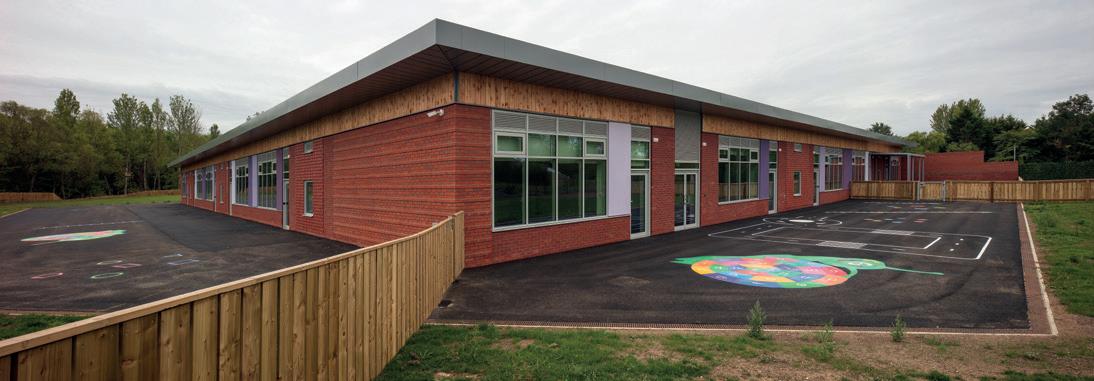
The design is organised around an internal courtyard to encourage independence among children, and provide a flexible, safe and welcoming environment. Classrooms are located around the courtyard with each having direct access to the external play area as the inter-relationship between indoor and outdoor learning/play is critical to the growth and development of each pupil.
The new school also benefits from its location within an established ecological setting close to the Middlesbrough Environment City and Nature’s World, in the south-western part of a green wedge called ‘Green Heart’.
Internal treatment
Internally, the school has been designed with passive supervision in mind and ‘blind spots’ avoided where possible.
In line with DfE requirements, the building comprises an administration suite, Early Years and KS1 Teaching Suite, KS2 Teaching Suite, Therapy Suite, main hall and Services
24
EDUCATION
Suite. There are two reception and nine primary classrooms, and in each teaching suite two small group rooms are provided to facilitate subject-specific learning for smaller groups and one-on-one teaching.
The internal and external spaces and approaches can be used safely, easily and with dignity by all, regardless of disability and impairment with entrances to the building, including the main entrance, convenient and welcoming with no disabling barriers.
Sensory appeal
Externally, two factors were key to the material selection of the building. Firstly, it was essential that the facade design should provide a rich, sensory experience through the juxtaposition of materials, textures and finishes. Secondly, the materials were to respond to and respect the predominantly natural context of the site.
Based on these factors, the overall building has been clad in red-facing brick; to break up the mass of the hall and contrast the brickwork at the low level, vertical and horizontal timber panels have been introduced above the door height – the natural character of timber responding appropriately to the wooded areas surrounding the development, and feature panels in four shades of purple have been introduced.
In summary
In completing this project successfully, Howarth Litchfield Director, Keith Handy, has drawn on his substantial specialist education design experience as well as his excellent working relationship with Tilbury Douglas. He said: “We were pleased to be able to work again with Tilbury Douglas because earlier projects have allowed us to develop an efficient working relationship and our teams are both committed to collaborating effectively with all stakeholders to understand their precise requirements.
“Together, we have created a building, which is a high-quality educational facility with a safe, flexible and stimulating learning environment for pupils. It will enable full integration of the academic, therapeutic and social curriculum and will be a welcoming place not only to its pupils and staff, but also to multi-agency professionals, parents, carers and, potentially, the wider community.”
Tilbury Douglas has a strong track record working alongside the DfE to successfully deliver education construction projects in primary, secondary, tertiary and higher-education facilities across the UK.


Paul Ellenor, Tilbury Douglas Construction’s Regional Director for Yorkshire and the North East, said: “At Tilbury Douglas, we are committed to providing first-class education facilities, and we are delighted to have successfully delivered the Discovery Special Academy, which will provide greatly-improved specialist facilities and an enhanced learning environment for students.”
www.howarthlitchfield.com
25
EDUCATION
“Together, we have created a building, which is a high-quality educational facility with a safe, flexible and stimulating learning environment for pupils”
– Keith Handy, Director of Howarth Litchfield
SUSTAINABILITY, SAFETY AND WELLBEING: IT’S ALL ABOUT THE FINISHING TOUCHES
The correct specification of paints, coatings and colour can support the sustainability and safety of dwellings – and even improve occupant wellbeing – while helping you create better spaces. In this article, Peter Howard, Sustainability Lead at Dulux Trade, delves deeper into these topics and offers up advice on the effective use of paints and coatings.

Sustainability is climbing the agenda for housebuilders looking to take a best practice approach and prepare for the Future Homes and Building Standard that comes into effect in 2025. It looks to cut carbon emissions in new homes by 75 to 80% and improve sustainability in existing properties through renovation works and extensions.
To effectively cut carbon emissions, it is crucial that housebuilders and developers consider the role of every aspect of the build – from the bricks and mortar down to the finishing touches. Paints and coatings play a vital role here, as they can preserve buildings and reduce the need for regular redecoration work, thus cutting emissions over the lifetime of a property. Opting for durable products, like Dulux Trade Scuffshield, will extend maintenance lifecycles thanks to Ultimate Scuff Resistant Technology that protects walls against scuff marks, making it perfect for high-traffic areas like communal corridors and living spaces. It is also cleanable and scrubbable, so any marks can be easily removed without the need to redecorate.
Water based is king
It is also recommended to use waterbased paints and coatings. Unlike solventbased products, water-based alternatives contain low volatile organic compound (VOC) levels. VOCs are chemical vapours that contribute to greenhouse gases, global warming, rising sea levels and ground-level pollution. Exposure to high levels of VOCs can also have negative effects on the health of the applier and occupant and cause symptoms like eye, nose and throat irritation, as well as headaches, loss of coordination and nausea in more severe cases.
Water-based paints and coatings not only have significantly lower VOC levels resulting in lower carbon footprints, but also deliver quicker drying times, so all coats can be applied much faster. Spaces also do not need to be ventilated, meaning occupants can move back in as soon as the paint has dried, reducing disruption. Water-based paints and coatings are also non-yellowing, meaning colours like white or lighter tones will stay looking their best for longer.
Safety first
When designing housing, the safety of occupants needs to be front and centre. Paints and coatings play a vital role here and must be compliant with Building Regulations. Approved Document B – which is concerned with the fire safety in and around buildings –says that internal linings in buildings should “adequately resist the spread of flame over their surfaces” and if ignited, “have either a rate of heat release or rate of fire growth which is reasonable in the circumstances”.
To achieve this, they must be compliant with BS 476-6: 1989 (also known as part 6) and BS 476-7: 1997 (or part 7) and achieve Class 0.
BS 476-6: 1989 refers to the amount of heat released when the product is burned and BS 476-7: 1997 (or part 7) looks at how quickly flames can spread across a surface. BS 476 also defines products based on four classes, with Class 4 indicating that the flame will spread across the surface rapidly and Class 0 showing that the spread of flame and heat released from the surface are limited. To achieve Class 0, a product must achieve Class 1 when tested to BS 476-7: 1997 and pass the test for BS 476-6: 1989.
26 HOUSING
It is also important to recognise that historic layers of coatings in older buildings can be a hazard and contribute to the spread of flames. To ensure the correct paint specification, the Dulux Trade team will work with customers to advise on the products needed to achieve Class 0 – like the Dulux Trade Pyroshield range that has been developed to inhibit the spread of flames across a painted surface.
A splash of colour
Once you have decided on the type of paint, the next job is working out what colours will make the space feel homely and welcoming. This means thinking beyond bright white walls and considering how colour can be used to brighten spaces and instil emotions in those that occupy them.
Over the last few years, interior design trends have incorporated the soothing and inspiring colours of nature. Between 2004 and 2007, cooler blues and greys were making their mark, whereas optimistic yellows featured between 2007 and 2013. Dulux Trade’s Colour of the Year 2023 –Wild Wonder – reflects the popularity of neutral tones.

Wild Wonder is a hue inspired by the warm tones of harvested crops and its upbeat glow looks to connect us with nature and create a sense of energy and positivity. To help identify complementary colours, there are also four trend palettes that all work in harmony with each other and Wild Wonder – making it easy to combine shades and create stunning spaces that occupants can feel at home in:
Lush Colours – beautiful forest hues that are inspired by the plant-filled habitats of gardens and woodlands. This palette places a focus on better mental health.
Buzz Colours – upbeat tones of pinks and ochres that capture the bustling biodiversity of a wildflower field or grassland to showcase the power of connections and community
Raw Colours – harvest shades that mimic nature’s raw materials, echoing the natural world to help make a building feel grounded and inspiring
Flow Colours – warm neutrals and deeper seashore tones that bring a sense of fluidity and momentum.
Bringing colour to life
The Dulux Trade Commercial Colour Services team have years of specification experience, and help professionals create beautiful and attractive spaces, using evidencebased research and principles focused on delivering the very best occupant experience. The team was hailed for their expert design support on a council-owned social housing regeneration programme by Exeter City Council that followed the principles of their Better Homes For Local People strategy that promises full and transparent consultation and involvement with those affected by building and renovation projects from the outset.
The process ensures there must be support from social housing residents for proposals at every stage of the process – placing them at the heart of decisions about the ongoing management and future of their estates.
A collaborative taskforce of Exeter Council, contractor CLC Group and the Dulux Trade team – led by AkzoNobel Specifier Development Manager, Bob McLellan –set itself a project to replace the existing magnolia and brown palette of a number of properties with something more uplifting.
A range of schemes were devised to optimise space, improve aesthetics and help to promote better outcomes for residents, who collaborated on the project and were invited to choose the one they liked best. The result was an enriching colour palette featuring cool whites and a range of natureinspired blues and greens, mixed with contemporary greys.

In summary, the correct specification of paints, coatings and colour can support the sustainability and safety of dwellings – and even improve occupant wellbeing – while helping you create better spaces.
www.duluxtradepaintexpert.co.uk/ en/content/occd-hub
27
HOUSING
PLANNED, PROACTIVE MAINTENANCE
Out of sight, out of mind, but not for long. Without an effective roof maintenance plan, minor issues can soon become major issues. Ian Dryden outlines how SIG D&T is working with schools to prioritise roof maintenance issues.

Fix a small problem immediately and it will prevent it from becoming a bigger problem later on. It is an idiom that could have been written with the maintenance of school and academy flat roofs in mind because a timely repair will save future expenditure and even replacement.
Funding, or the lack of it, is of course a major issue when it comes to schools and roof maintenance. But it is not the only issue. All too often there is a lack of expertise and foresight from those at the school with responsibility for maintenance but who have insufficient specialist knowledge.
In this situation, what tends to happen when a problem occurs is that an ill-informed person will, with the best of intentions, contact a roofing contractor – probably one found on the internet. This contractor will then offer a superficially low-cost, inappropriate short-term fix to win the work, which is very likely to result in the problem reoccurring in the near future and the process starting over again.
One particular challenge faced by those responsible for maintenance is the breadth of roofing knowledge needed because a school may occupy buildings of different ages and roof types, each of which have different requirements and challenges for both maintenance and repair. Another major issue is that roofs are often out of sight so minor problems can go entirely unnoticed for years until they become a major problem, by which time the remedial costs associated with the fix will be significant.
The most common flat roof problems that will need to be identified include:
Age
While modern roofing systems have a greater longevity than those of the past, your flat roof may have failed simply because it has reached the end of its natural life
Temperature
Solar gain can cause a roof membrane to heat up. However, insulation beneath the membrane retains this heat, causing older membranes to crack and blister.
Structural movement
All flat roofs and roof structures expand
and contract due to diurnal temperature variations. Modern flat roofs are developed to take this into account, older systems could fail prematurely.
Blisters
These are a sign that water is inside the roof system so that when the roof heats up, the water turns into vapour and tries to escape, producing pressure blisters
Delamination
This is where the roof membrane layers separate so that there is no longer a mechanical connection between them, which can cause the membrane to lift and fail
Poor design and detailing
Inadequate falls, supporting beams too far apart, interstitial condensation and poor detailing around upstands are all signs of poor design
Poor workmanship
Any system can be expertly designed, but if it is not installed correctly, it will fail.
A lack of detailed knowledge means that roof maintenance will invariably be reactive, occurring only when one of these problems becomes obvious and expensive to fix.
28 RCI
The alternative way of managing roof repairs is to use an ongoing routine involving regular inspection of the roof. Minor faults can be identified and fixed before they cause a problem – often removing the need for more significant (and costly) interventions later. The result of a detailed roof inspection will be a roof maintenance plan in which expenditure can be planned and budgeted for, because problems can be anticipated with regular assessment.
An annual roof survey will be sufficient to identify all issues, both minor and major. To help triage the issues effectively, a ‘traffic light’ system prioritises maintenance issues. This could look something like this:
Red –immediate attention/replacement of roofing systems required
Issue: For example, this may be a breakdown of the membrane, leaking in multiple areas
Requirement: This will require a stripping of systems and possible rebuilding from the deck up
Disruption involved: Major – closure of buildings until repaired Cost: Major.
Amber –attention required to avoid significant damage developing
Issue: Systems starting to fail, which may become significant in a year or so if no action is taken
Requirement: An overlay may be required to halt deterioration alongside other preventative measures

Disruption involved: Minimal, buildings undergoing works usually remain in use at school’s discretion
Cost: Medium, saving money in longer term.
Green –minimal or no work required
Issue: None to very minor wear
Requirement: Monitor roof to prevent deterioration, undertake minor maintenance Disruption Involved: None
Cost: None to very minimal.
Working with a partner, such as SIG D&T, this type of reporting will then result in a fouryear maintenance plan specific to a particular school, its roof types and their condition. The plan will be focused on heading-off minor roofing issues before they develop into major issues requiring expensive remedies.
Based on the issues identified, SIG D&T – a product-agnostic supplier – can even help advise on the most effective distribution of funds available to develop the most costeffective roof maintenance strategy, which will help the school reduce roof maintenance costs in the long term.

29 www.sigdandt.co.uk RCI
DELIVERING GARDEN COMMUNITIES: WHAT NEEDS TO CHANGE


David Churchill, Partner at Carter Jonas (London), considers what needs to be done to encourage new settlements. From a New Towns Act to a review of the green belt, something needs to give to deliver the required number of new homes.
The Government recently announced £15m in funding for the creation of garden communities. But the proposed funding is a drop in the ocean for one new garden village, let alone the 43 towns and villages listed. What it does indicate is the Government’s acceptance that we need a substantial number of new settlements: the housing crisis will not be resolved through brownfield sites alone.
Whether housing targets are here to stay is a moot point, but there’s no escaping the fact that we need roughly that number of new homes –300,000 per annum. In recent history, the only time when that number of new homes was delivered was in the context of the New Towns programme.
New legislation
The New Towns Act was very successful in allowing new towns to be created by development corporations. So to bring forward these 43 new settlements, do we require a similarly substantial piece of new legislation?
Providing enough new homes to solve the housing crisis and ‘levelling up’ across the country certainly requires change. But, ironically, the proposed solution – the controversial Levelling Up and Regeneration Bill – will limit rather than encourage growth of this type: with streamlined Local Plans and the scrapping of the Duty to Co-operate, instigating substantial new settlements will face additional limitations.
As with the New Towns Act, it could be appropriate for substantial new settlements to be considered outside of the Local Plan process. The Examination in Public stage, in particular, all too often stalls such schemes after considerable time and expense.
Secondly, although the Duty to Co-operate appears doomed, the principle of cooperation between local authorities must remain to deliver smart, sustainable growth that will meet the needs of the next generation.
A review of the green belt Also at the root of his problem is a misunderstanding, among residents but also some politicians too, about the green belt.
Green belts have existed since the first Town and Country Planning Act in 1947, as a means of preventing urban sprawl. In principle, a green belt is a ring of countryside around a town or city, in which development is resisted in favour of agriculture, forestry and outdoor leisure. But, in
30
TALKING POINT
David Churchill is a Planning Partner in Carter Jonas’ London office. He has over 20 years’ experience in the public and private sector and specialises in the promotion of large-scale projects in the housing, retail, employment and major infrastructure sectors.
reality, the green belt is far from the ring of rolling hills that some imagine: its boundaries were not drawn up in fine detail but with a broad brush, which sweeps up some of the least green and least pleasant sites. Furthermore, it is not uncommon for the requirements of the planning system to protect the green belt to be misinterpreted or misapplied, whether wittingly or otherwise: a situation that we have seen unfold multiple times.
We need to move away from the position whereby the green belt, as it is currently defined, is seen as sacrosanct, so that sustainable new homes can be delivered to ‘enhance’ and ‘green’ the green belt – as specified in the Levelling Up White Paper.


Coordinated approach to sustainable communities
If we are to see 300,000 homes built each year, and a substantial number on greenfield land, new developments must be sustainable. The future requirements for a biodiversity net gain, energy-efficient boilers and other sustainability goals address this to an extent. But an outstanding issue is transport. A recent report, Building Car Dependency: The Tarmac Suburbs of the Future, stated that new homes on greenfield sites continued to be designed around the car – often with as many as three parking spaces per home. The report criticised planners as having a ‘car-park to car-park’ mentality.
New housing on greenfield better served by public transport will become a reality only with genuine strategic planning and meaningful investment in infrastructure planning. The NPPF refers to the need for ‘identifying and coordinating the provision of infrastructure’ yet the approach to infrastructure in Local Plans tends to be limited and is compounded by the problem that within the two-tier system, transport planning is the responsibility of county councils, while Local Plans
are produced on a borough/district level. Again, this points towards the need for separate legislation for garden communities, one which exists outside the Local Plan process.
We have a responsibility to do better for the next generation – a generation whose homeownership aspirations are receding every year. We need to address and implement change, not just serve up more of the same.
31
www.carterjonas.co.uk TALKING POINT
WHY CHOOSING THE RIGHT INSULATION MATTERS
There are numerous insulation solutions available and making the right choice for a specific project can be difficult when specifiers must consider all the options. In this article, Paul Barrett, Head of Product
ROCKWOOL UK, explains how to evaluate different insulation options using the data provided by manufacturers.
The main function of insulation in buildings is temperature control. It is vital to keep the indoor climate comfortable and healthy, which means effective temperature regulation as opposed to simply keeping heat in. With the recent climate changes, hotter summers mean that insulation is also needed to keep the heat out. Without appropriate insulation, the increased demand to heat or cool buildings raises energy consumption, associated costs and CO2 emissions. Around 20% of greenhouse gas emissions in the UK are caused by heating buildings. The EU has calculated that proper insulation can reduce a building’s heating needs by up to 70%.
Building Regulations are clear about the level of insulation required for specific projects. There are different ways of using insulation to achieve the required thermal values and provide additional benefits.
Measuring thermal conductivity
The lambda (λ) value, also referred to as thermal conductivity, is a value indication of how well a material conducts heat. It indicates the quantity of thermal energy (W), which is conducted through a 1m² wall, in a thickness of 1m, when the difference in temperature between the opposite surfaces of this wall equals 1K (or 1ºC). In practice, thermal conductivity
is a numerical value expressed in terms of W/(mK). The lower the thermal conductivity value, the better the insulation property of the material. For example, the thermal conductivity value of steel is 50W/mK, whereas wood has a λ value of 0.12W/mK.
A more commonly-used value to express the thermal performance of the building fabric is the U-value. The thermal transmittance coefficient, U, expresses the transport of thermal energy through a structure. It represents the flow of heat (in W) through 1m² of a structure, when the difference between the two surrounding temperatures is 1K (or 1ºC). The thermal transmittance coefficient is expressed in W/(m²K). The lower the coefficient, the better the structure insulates.
Finally, thermal resistance, R, is a measure regularly used in construction. The R-value is the reciprocal U-value. Increasing the thickness of an insulating layer increases the R-value.
Insulation manufacturers are constantly working on improving the lambda value of their products by developing new ways of reducing the conductivity of insulation materials. Manufacturers, like ourselves, are always looking to enhance their product range with new solutions that improve thermal performance. NyRock, the next generation of stone wool, is an example of this. Our engineers have created a stone-
wool product with a more efficient fibre structure by enabling more air to remain between the fibres. This reduces its ability to conduct heat and brings the lambda value down to 0.032W/mK.
Decreasing the conductivity of insulation materials means that the thickness of the insulation can be reduced as well. When working to a U-value of 0.18W/m2K, specifiers can typically save around 15mm on the wall thickness with NyRock compared to traditional stonewool products. Applying that saving over a 22 x 22m building of nine storeys, for example, can yield an extra 99ft2 of usable or profitable floor space.
Beyond the thermal performance – fire safety
While the driving force behind insulation specification is to regulate internal temperatures, the latest changes to Part B of the Building Regulations reflect the growing role of insulation in the fire safety of buildings. From 1st December 2022, buildings that are categorised as having a residential purpose and over 11m in height will require external wall insulation classified as A2-s1,d0 or better in the Euroclass fire performance rating. This means that the insulation material has to be non-combustible. All other buildings above 18m require insulation with a minimum classification of A2-s3,d0.

32 TECHNICAL FOCUS
Management at
The Euroclass system determines a product’s fire performance by measuring a comprehensive set of characteristics, including ignitability, flame spread, heat release, smoke production and propensity for producing flaming droplets/particles. The classifications run from A1 to F, with products achieving A1 and A2-s1,d0 typically defined as noncombustible.
Acoustic performance of insulation
Another benefit of correctlyinstalled insulation is the protection from noise. In general, noise is any unwanted sound, independent of objective measurements. Growing population numbers mean more people live closely together in cities and houses of multiple occupancy. In these surroundings, insulation on all walls, floors and ceilings can considerably reduce noise pollution.
It is easy enough to measure the noise within a space after it has been built, but by then, remediation can be very difficult and expensive if required. As such, it is important to accurately measure noise levels during the planning phase to ensure that the building design will deliver the required acoustic environment once constructed.
Where projects utilise acoustic modelling in place of onsite environmental testing, a lack of real-world data can lead to over-engineered systems, which incorporate additional mass layers. The same is true of insulation products. To provide greater support when specifying stone-wool insulation for sound control, many ROCKWOOL products have been acoustically tested. The fibres in stone wool are randomly orientated, and as sound waves try to pass through the air trapped within the fibrous structure, they get absorbed by friction as the individual fibres are made to move back and forth.

In addition, the random orientation of the fibres gives rise to high tortuosity, which makes it very difficult for sound to find a path from one side to the other.

Getting the specification of insulation right is important – for the comfort and safety of the building’s occupants and to comply with regulations. Classifications and test data help and the technical teams of insulation manufacturers will assist you through every phase of your project.

33 www.rockwool.com/uk TECHNICAL FOCUS
LAMBDA VALUE ILLUSTRATION
LONDON BUILD 16-17TH NOVEMBER 2022

LONDON BUILD RETURNS FOR 2022


One of the UK’s leading construction and design shows will return to Olympia London’s Grand Hall from 16 to 17th November with more content, networking and entertainment than ever before.
This year, London Build will welcome over 35,000 visitors, 350 exhibitors and 500 speakers from contractors, developers, architects, specifiers, housebuilders, housing associations, civil engineers, Government, suppliers and construction professionals.
Learn the latest insights and updates on major upcoming construction projects and opportunities from across the UK, with eight conference stages exploring the future of construction, architecture, sustainability, diversity and inclusion, fire safety, BIM and digital construction and skills. Visitors have the opportunity to build their training and education with over 200 hours of CPD-accredited sessions.
This year also sees the launch of two new stages. The Architecture Stage will host speakers from the UK’s biggest architectural firms, including Foster + Partners, BDP, Zaha Hadid Architects and more. Held in partnership with Architecture Social, panellists will discuss everything from inclusive design to the role of architecture in overcoming the housing crisis.
London Build will also be launching its Skills Hub, where visitors can learn about the latest insights and tools the industry has to offer. There will
be numerous workshops held over the two days, including ‘Creating the Ultimate Marketing Plan’, ‘Developing Inclusive Employment Strategies’, ‘BRE and BIM’, ‘The World of TikTok Marketing’ and more.
London Build 2022 will also see the return of the Architect’s Hub, where visitors will have the chance to see projects from the UK’s top architects, including Scott Brownrigg, SOM, PLP Architecture. Come face to face with a wide range of 3D models and designs of the most exciting projects based in London and the UK. The Architect’s Hub will also host the inaugural ‘Architecture Social’ awards, hosted by Founder Stephen Drew.
The ever-popular Meet the Buyer area will showcase the latest opportunities and tenders from procurement teams at Skanska, Costain, Balfour Beatty, SMP Alliance, BAM UK and more. Don’t miss out on the opportunity to increase your brand profile to potential new clients.
London Build is home to the UK’s biggest Festival of Construction, and this year, it is bigger than ever. There are DJs, musicians, live performances, prize giveaways and even celebrity guests, including England football legend Kevin Keegan. There’s also the London
Build food and drink trail, where visitors can taste and try artisan food and drink products from around the UK.
Make sure to check out the Built Environment Networking Hub, where you can take to the stage at the BIM Open Mic, learn how the LCEC is driving change over complimentary breakfast and connect with sustainability professionals from across the UK, all under one roof. Your ticket gives you access to all of the networking parties taking place over the two days, co-hosted with Urbano Build, London Constructing Excellence Club, Forum for the Built Environment, The CIOB, Building People, Let’s Build, Building Equality and many more.
The Built Environment Networking Hub is also home to the UK’s largest annual networking events for women in construction and diversity in construction, where visitors can learn from an inspiring panel of industry leaders as they celebrate the successes and discuss the challenges facing AEC professionals. Network with fellow professionals and feel inspired by the diverse stories that make up one of the most exciting industries.
London Build works with an incredible team of women in construction and diversity
www.londonbuildexpo.com
SHOW OPENING TIMES:
16th November: 9.30am - 5.30pm
17th November: 9.30am - 4.30pm
in construction ambassadors who are furthering equality in the built environment. This year’s Ambassador Programme also includes the launch of the London Build Mental Health Ambassadors.
Working in partnership with Construction Sport and Mates in Mind, the London Build Mental Health Ambassadors are working to get the sector talking, to help challenge the perceptions around mental health. Join the Mental Health in Construction Networking event on 17th November, where you can network with the London Build Ambassadors and learn how you can help challenge the stigma surrounding mental health in the UK’s built environment.
Needless to say, this is a must-attend event for every construction professional in the UK. Register your free tickets today using the website below.
34
SHOW PREVIEW
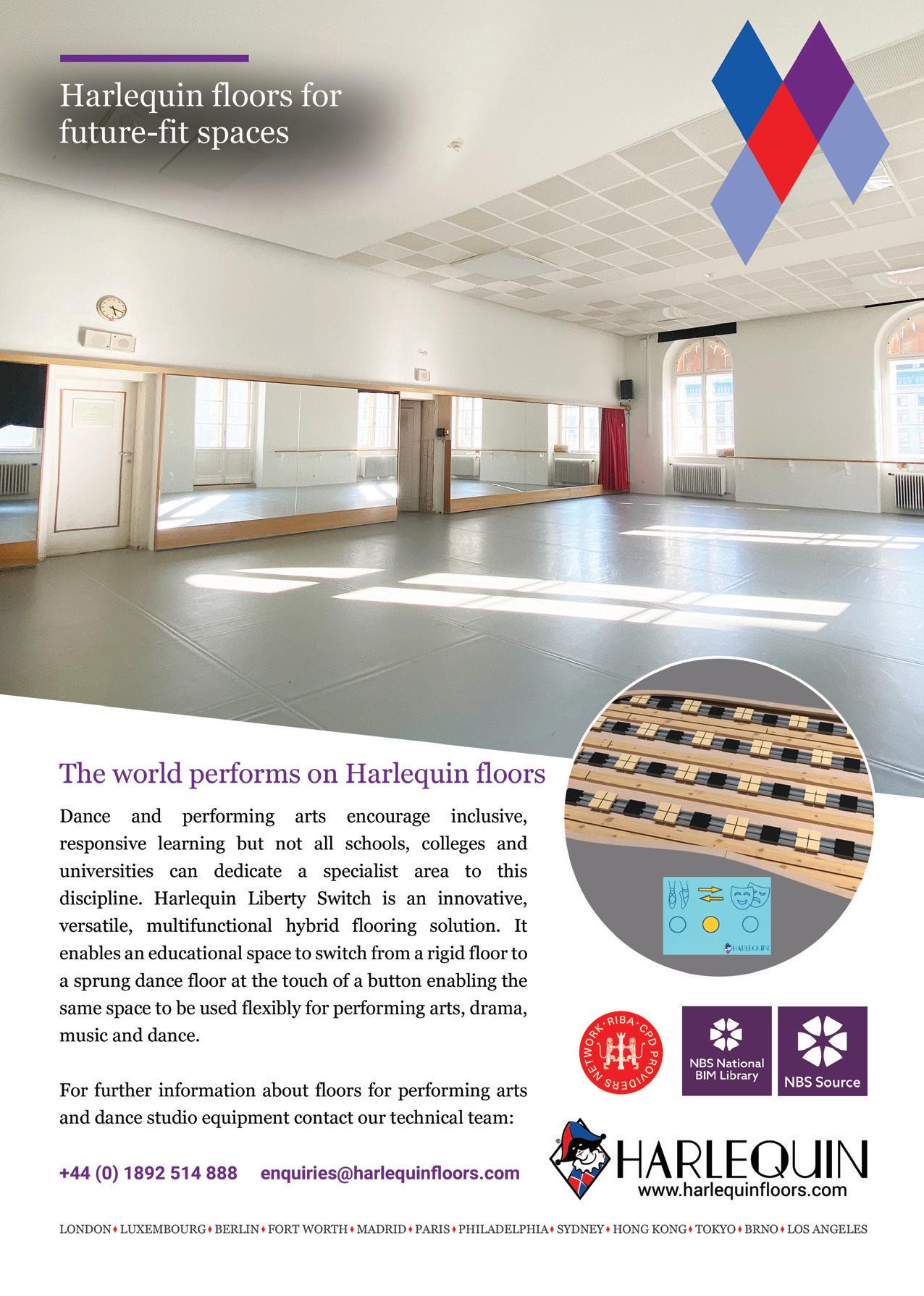
HOW CROWN COMMERCIAL SERVICE IS SUPPORTING LOCAL AUTHORITIES
From programmes of repair and maintenance to major refurbishment and new-build projects, CCS is helping local authorities bring power to their construction procurement.
Crown Commercial Service (CCS) plays an important role in helping the UK public sector save money when buying common goods and services. It is one of the biggest public procurement organisations in the UK and uses its commercial expertise to help buyers across the public sector on a range of issues, including building and maintenance agreements.
How CCS is supporting local authorities
CCS knows that local authorities are under pressure to make their budgets work harder. The organisation focuses on saving you time and money, allowing you to get on with what matters most; providing the best possible outcomes for your local communities.
CCS works with individual local authority colleagues, regional and national sector networks across the UK, as well as important stakeholders, such as the Local Government Association, to support the sector.
You’ll be supported throughout the buying process to ensure you make the most of every pound spent.
What is a framework and what benefits can they bring to public sector buyers?
CCS frameworks help public sector buyers to procure goods and services from a list of pre-approved suppliers, with agreed terms and conditions and legal protections.
Frameworks can remove the need for customers to run their own lengthy and expensive tender processes.
They are often divided into ‘lots’ by product or service type. The number of suppliers varies, depending on what is being offered. Some frameworks have only one supplier offering complex, end-toend services, while others will have many more.
What can you buy through a framework?
In addition to tens of thousands of common goods and services, CCS offers a number of building and maintenance frameworks covering: construction, modular buildings, management and maintenance, waste management and energy supply. So whether you’re building a new school or carrying out repair work, CCS is likely to have a framework for you.
What protections do frameworks give?
Frameworks can help you identify a list of suitable suppliers that have signed up to pre-agreed terms and conditions.

This means all you need to do is follow the award process in the contract or in the customer guidance that CCS provides for its frameworks.
Supporting your construction projects
CCS offers the largest number of construction commercial agreements in the country. Its construction agreements include all of the policy areas set out in the Construction Playbook, giving you the assurance that you are contributing to a more robust and sustainable industry, which can help the economy to grow.

The organisation’s frameworks have social value at their core, to ensure that what you buy creates additional benefits for society, whether that is creating more apprenticeships for young people or assuring supply chains are free from modern slavery and many have been designed to help you work towards your net-zero targets.
To find out more, visit the website below and download the updated digital brochure.
www.crowncommercial.gov.uk
36 PROCUREMENT
0345 410 2222 info@crowncommercial.gov.uk






37 KEMPEROL® Liquid Roofing & Waterproofing Long term protection for flat roofs, buildings and critical structures Warm roofs, inverted roofs, green roofs, podium Whatever your requirements, we have a certified and proven solution to meet your needs. Contact us to discuss Kemperol Liquid Waterproofing KEMPEROL® The first choice for liquid membranes 95/3139 visit www.kemperol.co.uk To find out more about the KEMPEROL® range of products Tel: 01925 445532 Email: enquiries@kempersystem.co.uk Whether it’s a school, hospital, hotel, car park, balcony, the list is endless, KEMPEROL® has a range of cold applied products to suit every application. With over 60 years’ experience, there’s not many challenges we haven’t faced, confronted and overcome. 06/4388
THE POWER OF HEALING ARCHITECTURE
The Sct. Hans Hospital in the Danish city of Roskilde is a psychiatric facility specifically designed to provide the healthiest of environments for staff and patients and has just won the prestigious Danish ‘Health Building of the year’ award.

Forming a larger extension to the original hospital, the new 21,000m 2 complex, designed by KHR Architects, includes a new 126-bed psychiatric ward and therapy facilities built into the side of a hill and nestled within carefullylandscaped grounds to provide privacy while maximising the views. The use of nature and light, along with modern and effective design and building materials, makes for a calm, tranquil and light environment.
As part of the design, Troldtekt wood-wool acoustic panels in different colours have been used for the ceilings to link various zones in the communal areas and activity rooms. In the therapy baths, the panels are a muted grey colour to exude a sense of calm. This choice of materials plays a key role as materials like wood adds warmth and naturalness. The materials, together with the good acoustics, contribute positively to the healing process.
Founded on the Cradle to Cradle design concept and recently attaining Gold certification, Troldtekt’s natural and inherentlysustainable panels are available in various surfaces and colours and contribute positively to a building’s BREEAM, DGNB and LEED ratings. In addition to their high sound absorption and tactile surface, they offer high durability and low-cost lifecycle performance. Available in various sizes and in four grades, from extreme fine to coarse, the panels can be left untreated or painted in virtually any RAL colour.
WHY DO THE WORLD’S LEADING DANCE UNIVERSITIES AND SCHOOLS CHOOSE HARLEQUIN FLOORS?
Dance students can spend hours working in a dance studio, it is their place of work and should offer a safe environment that is fit for purpose. The floor is a dancer’s most important work tool and dancers need reassurance they are not going to slip and fall, that lifts can be performed safely and, on landing from jumps, the response of the floor consistently returns the right amount of energy absorption.

It is a common assumption that a well-designed sports floor will suit the needs of dancers, but this is not the case. There are some critical factors that distinguish the requirements of dance from those of sports played on a sports floor. Unlike sportspeople who wear increasingly high-tech aircushioned shoes to give grip and protect against impact injuries, the modest ballet shoe has barely changed in design since the mid-18th century. Made from soft leather, canvas or satin, the ballet shoe is very flexible, has a thin sole and offers little protection for the wearer.
But not all dance floors are the same, only a floor developed specifically for dance will do. There may be a temptation to specify floors for aesthetic or budget reasons, or to specify sports floors in the mistaken belief they will be suitable for dance but there have been some high-profile examples where floors have had to be replaced by a dance company after the building is complete and dancers have their first experience of dancing on the floors.
Harlequin is widely recognised as one of the world’s leading authorities on dance floors. As an enlightened manufacturer, Harlequin has always worked closely with the dance community to develop floors that dancers want to dance on. For over 40 years, Harlequin has been the performance floor of choice for the world’s most prestigious dance and performing arts companies, theatres, venues and schools.
www.troldtekt.co.uk 01978 664255 www.harlequinfloors.com 01892 514888 architects@harlequinfloors.com
38
CEILINGS
FLOORS,
WALLS &
Tried, trusted and tested for almost 40 years, our roof ventilation terminals, window and wall ventilators and acoustic ‘room to room’ air transfer units are used in a variety of applications from classrooms and workshops to sports halls and atriums.





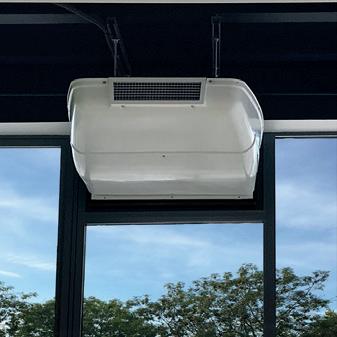
39
ventilation
for the education
Keep
flowing projects@passivent.com cpd@passivent.com | +44 (0)1732 850 770 www.passivent.com Ventilation & Air Quality Natural Daylight Moisture Removal
For further information, technical support or to request a CPD, contact Passivent today. Our range of natural and hybrid ventilation products provide sustainable and energy-efficient solutions for improved indoor air quality, thermal comfort and occupant wellbeing. Expert
solutions
sector
inspiration
NEW SCHÖCK SCONNEX FOR MAJOR PASSIVHAUS SOCIAL HOUSING SCHEME

Minimising thermal bridging at the wall connection to the floor or floor slab is an ongoing problem with reinforced concrete construction. However, a dedicated new solution – the Sconnex type W – has been developed by Schöck and is being installed in what is currently the largest Passivhaus-accredited social housing scheme in the North of England.
The ‘Greenhaus’ nine-storey development of 96 affordable homes in Chapel Street, Salford, is part of the 50-acre Salford Central regeneration and the result of a collaboration between The English Cities Fund (ECF) – a national development partnership between Muse, Legal & General and Homes England – contractor Eric Wright Construction and Salix Homes. The scheme focuses on sustainability and is designed to reduce the energy consumption of the building. With Passivhaus, energy savings can be as much as 90% compared with the average building stock and more than 75% compared to average new builds.
Thermal losses are greatly reduced

The unique Schöck Sconnex type W makes a major contribution to achieving this initiative and is a product based on derivative technology from Schöck. Sconnex utilises the company’s longstanding expertise in structural thermal breaks for balconies and other cantilever constructions and applies it to reinforced concrete wall and support applications.

By installing the Sconnex product in Chapel Street, thermal losses are greatly reduced, and the surface temperature in the rooms increases to considerably more than the critical dew point temperature. Heating costs are lower, a pleasant room climate is created and the linear thermal transmittance (Psi) of the connected reinforced concrete wall is reduced by as much as 80%. This outstanding insulation performance is combined with an excellent load-bearing capacity. It transmits very high pressure, tensile and shear forces, in the longitudinal and transverse direction, made possible by the use of a pressure buffer consisting of ultra-high-performance, fibrereinforced concrete. Compressive strength levels in excess of 175N/mm2 are achieved, with extremely good flexural strength. A further important benefit is the significant cost reduction involved when compared to installing insulation beneath the floor slab.
Eric Wright and Salix have key roles Greenhaus forms part of ECF’s wider £1bn, 50-acre Salford Central masterplan transforming former surface car parks and
derelict buildings into a vibrant and diverse community. John Hartnett, Managing Director at Eric Wright Construction, comments: “We are proud to be supporting not only a green future for Salford, with the delivery of high-efficiency buildings built to Passivhaus standards, but also supporting Eric Wright’s own journey to net-zero carbon. These new homes will deliver valuable social housing in partnership with Salix Homes.“
Sue Sutton, Chief Executive at Salix Homes, also adds: “Chapel Street enjoys an incredibly rich history and the innovative Greenhaus development marks the next exciting chapter for this historic part of Salford. At a time when affordable housing is in such short supply, we’re very proud to work alongside our partners to deliver these high-quality, sustainable, eco-homes of the future, and we look forward to seeing this ambitious development take shape on the Salford skyline.”
www.schoeck.com/en-gb 01865 290890 design-uk@schoeck.com
40 FOCUS & INNOVATION
A graphic of the Sconnex type W in position
The Sconnex type W product
POLYPIPE BUILDING SERVICES LAUNCHES GUIDANCE ON DRAINAGE SYSTEM BEST PRACTICE FOR PUBLIC SECTOR RMI PROJECTS
With the launch of the Better Social Housing Review in June bringing an increased focus on the importance of refurbishing ageing public housing stock, Polypipe Building Services has announced the launch of a whitepaper offering guidance on one of the most complex and time-consuming RMI challenges – drainage system replacement.
Following Government debate regarding the condition of some social housing in the UK, the independent Better Social Housing Review has been established to make practical recommendations to social housing providers to tackle problems from damp issues to communication with tenants. This has placed a renewed focus on how RMI projects can deliver best value and minimise disruption for residents.
Given the nature of the work involved, drainage system replacement can often represent a large portion of such projects. As Graham Hicks, Project Development Manager at Polypipe Building Services, explains, this means specialist focus is needed.

“Replacing the drainage stack in a large, residential building is a significant piece of remedial work and, inevitably, means a period of time where residents are unable to use sinks, toilets and other
facilities. Furthermore, given the nature of older buildings, there has usually been a degree of renovation or reconfiguration work already undertaken, which means planning exactly what needs to be replaced and how can be extremely complicated.
“Getting drainage replacement right can often be make or break as to whether an RMI project overruns or causes unexpected disruption to residents. That’s why we have launched our latest whitepaper that gives specialist advice on what should be considered for this type of work.”
Based on case studies from recent public sector RMI projects, the whitepaper outlines key considerations for building owners and contractors so they can ensure drainage system replacements are carried out as efficiently as possible – helping to support the drive to improve the condition of the UK’s social housing stock.
The whitepaper can be downloaded from the Polypipe website below.
www.polypipe.com/drainage-stack-replacement 01622 795200 commercialenquiries@polypipe.com
ASWS SHOWS FORENSIC ATTENTION TO DETAIL IN WHITELEYS WINDOW REMOVAL www.asws.co.uk 0208 665 5335 info@asws.co.uk
Associated Steel Window Services (ASWS) has reflected with pride on the complexity of the challenges it faced in carrying out its largest-ever survey and detailed removal project as part of the £1bn redevelopment for the former Whiteleys Shopping Centre in west London. Contracts Director of ASWS, Kris Bennell, comments: “We were appointed by Erith Contractors to painstakingly deglaze some 2000 copper lights, and dismantle the steel frames along with the half-ton cast-iron mullion and fascia sections. Everything was tagged, catalogued and stored separately in crates and palletised for transport to our facility at Gatwick. This was, at the time, the largest refurbishment project being undertaken in Europe and we were very proud to be involved.”

FIREFLY PHOENIX OFFERS TEMPORARY FIRE PROTECTION FOR FENCHURCH STREET OFFICES

The refurbishment of two complete floors to one of the city’s largest office buildings is making use of the well-proven and versatile TBA FIREFLY Phoenix smoke and flame barriers to create temporary fire barriers while the work is being carried out: protecting people and property across the rest of the five-storey structure where business continues as normal. In total, T&R Fire Protection has fixed 22 rolls of the lightweight Phoenix material to create the twohour integrity smoke and flame barriers around the glazed edge of the floor plates at levels three and four of 30 Fenchurch Street.

www.tbafirefly.com 01706 758817 technical@tbafirefly.com
THERMOBLOCKS MAINTAIN CONTINUITY TO ‘WRAP’
Bristol-based architecture firm Marshall & Kendon recently sought technical advice from manufacturer Marmox, regarding the integration of its Thermoblocks into the exterior insulation ‘wrap’ of a bespoke, near-to-zero timber frame construction. Founding Partner of Marshall & Kendon, Jeremy Marshall, confirmed: “It is our habit as a practice to always run insulation across the outside of the structure, wrapping them rather than putting it within the timber frame. In this instance, Thermoblock enables us to make the layer of insulation continuous as it passes through the loadbearing structure, while the airtightness membrane is continued up the outside of the sheathing boards.”
www.marmox.co.uk 01634 835290 sales@marmox.co.uk
41
FOCUS & INNOVATION
BESPOKE BRISTOL HOUSE BUILD
SMS LAUNCHES NEW EV CHARGEPOINT INFRASTRUCTURE SOLUTION
Energy solutions business, SMS plc, has launched an end-to-end electric vehicle (EV) chargepoint infrastructure solution to help UK organisations establish, manage and grow their car-charging networks.


The new service offers businesses looking to invest in and monetise EV chargepoint assets a full lifecycle proposition, from initial consultancy and design of electrical infrastructure, through to technology procurement, installation and ongoing operation and maintenance (O&M).
SMS will deliver its managed chargepoint solutions as a fully-funded or part-funded service, helping to significantly lower the financial barrier
organisations face when deploying the technology at scale.
In partnership with chargepoint operator (CPO) and software-as-a-service (SaaS) company, Clenergy EV, SMS will also offer access to innovative chargepoint management software that allows organisations to manage and monitor all aspects of their business charging network via an Open Charge Point Protocol (OCPP)compliant platform.
With a recent report commissioned by Transport and Environment (T&E) highlighting that there are currently more EV chargepoints in workplaces (33,000) than public chargers (31,500), SMS looks to assist private and public sector organisations across both of these key market segments, supporting the UK Government’s EV Infrastructure Strategy to reach 300,000 chargepoints nationwide by 2030.
In addition to workplace and public charging, SMS is also targeting the destination charging market – which broadly refers to chargepoints installed by leisure, retail and hospitality businesses –as well as the fleet sector.
SMS brings to the EV charging marketplace significant energy consultancy and engineering heritage, with the company having played a leading role in delivering some of the UK’s flagship utility infrastructure programmes over recent years. This includes the Governmentmandated smart meter rollout, the development of grid-scale Battery Energy Storage Systems (BESS) and expert electrical infrastructure support for the telecom industry’s new 5G networks.
Guy Bartlett, Managing Director of SMS’ Energy Services division, said: “As an independent, tech-agnostic EV charging partner, other than our considerable expertise helping establish the UK’s critical electrical infrastructure, what we look to bring to the rapidly-growing chargepoint market is a crucial flexibility of choice. Unlike many of our closed network competitors operating in this space, our goal is to help customers seize total control over who supplies their chargepoint estates, helping select the hardware that best fits their precise business needs, whilst also providing the engineering skills to deliver an optimum charging solution.
“At SMS, we believe that encouraging and enabling interoperability across the UK’s EV chargepoint network is essential to helping create the best possible experience for drivers, which will, in turn, improve general uptake of EVs and, ultimately, help strengthen the business case for investing in chargepoint infrastructure. That is why we’ve chosen to partner with Clenergy EV and offer our customers the benefit of OCPP-compliant software, which allows network owners to control chargepoints from multiple manufacturers via one platform.
“We also believe that cost should not stand in the way of businesses who wish to benefit from the many commercial and environmental advantages made available by EV charging assets. We’re proud, therefore, to offer the marketplace our funded solutions that remove one of the major obstacles to asset investment.”
www.sms-plc.com 02920 054151 evcharging@sms-plc.com
42 FOCUS & INNOVATION
ROCKWOOL PIPE SHOWCASED IN DRAMATIC GIANT MODULAR SCULPTURE
An exciting new piece of artwork by Artist, Lubna Chowdhary, has taken heating and ventilation pipe to the next level with an impressive 6.5 x 5.5m sculpture, which embodies the growing trend for exposed pipework as an architectural design feature.
The Erratics exhibition was commissioned by the Middlesbrough Institute of Modern Art (MIMA) and features a sculpture made possible by a ROCKWOOL donation of 320m of its RockLap H&V Pipe Sections, sized with a 140mm inner diameter and wall thickness of 25mm.
The Artist, Lubna, has previously created many commissioned architectural works and the ROCKWOOL piece, Modular 4, continues the tradition of her site-specific work, playing with scale, repetition, modularity and geometry to occupy the expansive gallery space at MIMA.

The ROCKWOOL insulation used for the sculpture consists of preformed cylindrical sections of stone wool with a layer of factoryapplied foil on the outer surface. Traditionally used for heating and ventilation pipes in a range of settings, RockLap H&V pipe sections are designed to maintain the optimum temperature of pipe services, thereby reducing energy consumption.
Speaking about her repurposing of ROCKWOOL insulation for Modular 4 and treating it as an unconventional sculptural material, Lubna said: “My work continuously investigates the relationship between the industrial and handcrafted, and the
ENERGY CRISIS FUELS GROWTH FOR FOAM SEALANTS IN 2023, SAYS SECTOR LEADER

The energy crisis will ‘significantly fuel’ growth for window and door foam sealant tapes in 2023, according to Andy Swift, Sales and Operations Manager for ISO-Chemie. He sees the UK market remaining robust over the next 12 months, with the need for more effective insulation and sealing solutions for windows and doors becoming a rapid priority in the design, specification, new-build housing and wider commercial construction sectors. Refurbishment of existing housing stock is also expected to support growth in 2023, says Andy, as retrofitting sealing solutions can be a more effective way to achieve greater energyefficient homes rather than building new properties. Indeed, national housing associations, such as Broadacres Housing Association and Gateshead Housing, have been upgrading their current stock with new door and window installations sealed by foam tapes. In the modular sector, house designers will continue to invest in new ways to deliver low-carbon structures, which use sustainable technologies, such as foam sealant tapes, to secure measurable airtight, acoustic and thermal sealing benefits.
www.iso-chemie.eu/en-GB/home
a.swift@iso-chemie.co.uk
industrial precision and modular system of ROCKWOOL was something I could work directly and immediately with. It was a material that could be easily formed and constructed into more complex shapes with minimal tools and processes.”
Commenting on the use of ROCKWOOL RockLap H&V Pipe Sections, Will Wigfield, HVAC & Fire Product Manager at ROCKWOOL, said: “Our HVAC products are often deliberately left exposed in modern commercial, retail and leisure projects to provide an attractive and interesting focal feature that blurs the line between function and aesthetics. It is fascinating to see how Lubna has taken this one step further and transformed RockLap into such a stunning and imposing piece of art. ROCKWOOL was pleased to be able to donate these materials and see them transformed into something so special.”

www.rockwool.com/uk 01656 868490 technical.solutions@rockwool.co.uk
Advanced, a world leader in intelligent fire, evacuation and emergency lighting systems, will be exhibiting on stand E64 at London Build 2022 (16 to 17th November at Olympia London). Here, the company will be offering visitors guidance on how Advanced’s systems fit into the recent amendments to Part B (Fire Safety) of the Building Regulations, which come into effect on 1st December 2022. As well as sharing knowledge with visitors, the company will also be showcasing its latest evacuation alert and fire safety solutions. The amended Approved Document B of the Building Regulations was published in June 2022 and offers improvements to fire safety guidance to ensure tall buildings are made safer in England. Advanced welcomes these improvements and will be on hand at London Build to help those involved in the design or construction of residential developments to explain the changes relating to evacuation alert systems and to give guidance on how to comply.
43
FOCUS & INNOVATION
07837 337220
ADVANCED OFFERS FIRE SAFETY GUIDANCE AT LONDON BUILD AHEAD OF BUILDING REGULATIONS DEADLINE
0345 894 7000
uk.advancedco.com
evacgo@advancedco.com
SIG BUILDING SOLUTIONS ENTERS SOLAR CAR-PARKING STRUCTURE MARKET
SIG Building Solutions has entered the solar car-parking structure market with a range of designs developed to help public and private sector organisations with large parking facilities to capitalise on the opportunities the structures provide for generating solar energy and reducing their carbon footprint.
Designed and manufactured in the UK from UK-held steel stock, SIG Building Solutions’ structures can be developed, manufactured and delivered in a matter of months, depending on planning approvals. SIG works in conjunction with the solar system provider to provide the structure element.
With a number of solar car-parking structure projects already in the pipeline for SIG Building Solutions, including large commercial and industrial schemes, the business is well positioned to continue to meet the growing demand.

Guy Chilvers, SIG’s Solar structural canopies Business Development Manager, has spent 10 years in the market, including five years specialising in car-parking structure design with involvement in projects such as Bentley Motors, Crewe and Falkirk Council’s EV Hub, which has 200 parking spaces and was officially opened in September 2020.
He says: “With solar car-parking structures, any organisation with a significant area of parking space can generate power and save money. At the same time, the watertight canopies help to protect vehicles from the elements. Our structures are designed to

have a fully watertight canopy, guttering and cable containment.”
In 2017, SIG Building Solutions company Steadmans manufactured the steel framing for the Bentley Motors solar car-parking structure in Crewe, which covers 1200 carparking spaces and provides 25% of the electricity demand for the factory. Darren Hall, Steadman’s Commercial Director, said: “Having supplied the steelwork for the Bentley project, we are excited to have reentered the market.”
During 2022, SIG Building Solutions has developed a range of structure designs for the commercial market with the aim of providing an ‘off-the-shelf’ solution at a viable price. The investment has resulted in unique structural designs that require less steel, so reducing the cost, and can be installed efficiently to minimise disruption to carparking during installation.
SIG offers a choice of canopies depending on clients’ requirements and onsite analysis. The options are based around three main designs: a double-gull wing design ideal for east-/west-facing panels; a double-mono version providing maximum area for southfacing panels; and a single-row structure specifically designed for EV chargepoints.
“To specify the most effective structure, SIG Building Solutions undertakes a complete analysis of potential car parks, looking at location, shading, drainage and power requirements. The location of the canopies within the car park and orientation is vital to obtaining a good return on investment,” says Guy Chilvers. “Renders of the site are produced to support the quotation and these can be used for planning applications.”
Adds Guy: “Hospitals, schools, leisure centres, airports, office complexes, factories, shopping centres and railway station car parks – really the scope for solar car-parking structures is tremendous.”
www.sigbuildingsolutions.co.uk
44 FOCUS & INNOVATION
07528 777513 guychilvers@sigbuildingsolutions.co.uk
FOR SUSTAINABLE PVC PRODUCTS, LOOK FOR THE VINYLPLUS PRODUCT LABEL

Vincent Stone, Technical and Environmental Affairs Senior Manager at VinylPlus, explains how the VinylPlus Product Label makes it simple for public and private procurers alike to choose and shop responsibly for high-performing and sustainable PVC products that contribute to a circular economy.
The VinylPlus Product Label is a sustainability certification scheme, which makes it easy for customers and markets to identify the most sustainable and high-performance PVC products for the building and construction sectors. Currently, the scheme covers the PVC building products as defined in Article 2 and Annex I of the EU Construction Products Regulation 305/2011.
The VinylPlus Product Label is a wellrecognised Europe-wide sustainability certification scheme for PVC products in building and construction sectors. It serves as a guiding tool for public and private buyers looking to select PVC products with the best sustainability profile. Durable, robust and recyclable, PVC is a versatile material used in myriad long-life and low-maintenance building products, from window profiles to pipes and cables.
Key sustainability criteria
Launched in 2018 by VinylPlus, the European PVC industry’s commitment to sustainable development, and developed in collaboration with the Building Research Establishment (BRE), the VinylPlus Product Label is awarded to VinylPlus partner companies whose overall policy and performance, as well as component materials used for products, fulfil 20 key sustainability criteria.
These criteria include the responsible sourcing of PVC resin and additives, controlled loop management and recycling, as well as sustainable energy policies, and organisational and supply chain management requirements.
In 2021, the VinylPlus Product Label was recognised as the first Responsible Sourcing Certification Scheme (RSCS) dedicated to plastic building and construction products in both BREEAM and Home Quality Mark (HQM), two schemes owned by BRE.
BREEAM is the world’s most-used sustainability assessment method for measuring the environmental, social and economic sustainability performance of buildings, from planning projects and infrastructures to buildings. HQM is a certification scheme, which helps UK housebuilders to demonstrate the quality and sustainability performance of their new homes. Both schemes are widely used by public procurers in Europe to measure the sustainability requirements of their building projects.
Achieve higher BREEAM and HQM scores
Thanks to BRE’s tough yet successful assessment of the VinylPlus Product Label, owners of buildings selecting PVC products certified with any versions of the VinylPlus scheme can automatically achieve higher BREEAM and HQM scores. This helps them to increase the market value of their BREEAM- and HQM-certified properties.
Continued recognition and use of the VinylPlus Product Label has contributed to its success across the UK and Europe. Currently, a total of 153 PVC products manufactured by 11 converters in 22 European plants are certified.
According to Brigitte Dero, Managing Director at VinylPlus: “The VinylPlus Product Label confirms our commitment to strengthen the positive social, economic and environmental impact of PVC.”
productlabel.vinylplus.eu info@vinylplus.eu

45
FOCUS & INNOVATION
Vincent Stone, Technical and Environmental Affairs Senior Manager at VinylPlus
CHOOSING THE RIGHT SUSTAINABLE WOOD FINISH
Choosing the right finish
A sustainable solution
The foundation of Osmo wood finishes is based upon purified and refined natural resources, which are carefully harvested into natural oils and hard waxes. Osmo products contain natural

vegetable oils to help nourish the wood and retain flexibility. Depending on the product, they might include linseed oil, sunflower oil, soybean oil as well as thistle oil. The interior range of hard wax oil products also
contains natural plant waxes, carnauba wax and candelilla wax, offering wear resistance and repellency. Furthermore, its extensively-cleaned pigments have been approved for use in the food industry.
Osmo’s mission is to preserve the natural beauty and durability of wood with only the highest quality and environmentally-friendly products. Items made from wood, from flooring to furniture, are made from organic matter, so they will continue to need nourishment to ensure the product stays in the best possible condition, both aesthetically and structurally. Osmo’s advice is to make use of a highquality finish, full of natural ingredients to complement the wood’s properties. This will ensure that the wood continues to breathe and respond well to environmental conditions, removing any possibility of cracking or and blistering.
FSC certification
Osmo supports sustainable forestry and works diligently to ensure that the origin of timber used can be proven. To help improve, and with natural resources in mind, Osmo has taken on the high standard of FSC certification for certain products. In choosing an Osmo product, you can be reassured that the product is not just good for wood, but good for the environment too.
Consumers today are more conscious than ever about the sustainability credentials of the products they buy and use. There is a clear trend for switching to more sustainable and environmentally-friendly products. That’s why so many people turn to Osmo when looking for a wood finish – its products are not only high-quality, durable and easy to maintain but they are also made from sustainable ingredients. www.osmouk.com

46 FOCUS & INNOVATION
com
01296 481220 info@osmouk.




47 • Fire Rated to A2-s1, d0 & A2fl-s1 • Aluminium construction to 6063 T6 grade • Slip-resistant and wear-resistant • 30-year manufacturer product warranty To find out more about the AliDeck System, call our team today! THE UK’S ORIGINAL FULLY COMPLIANT ALUMINIUM NON-COMBUSTIBLE BALCONY DECKING SOLUTION Call: 01622 534 077 Email: info@alideck.co.uk www.alideck.co.uk ALIDECK BALCONY DRAINAGE SYSTEM ALIDECK JUNIOR BALCONY BOARD This innovative drainage solution delivers positive drainage to balconies, with our Drainage Channel between the deck boards capturing and directing water to the Drainage Gutter for controlled evacuation to a specified outlet. The 20mm AliDeck Junior Board is our most popular decking board, available in ridged and flat specification. Spanning up to 600mm, the cost-effective Junior Board requires less underside support than traditional decking and is non-combustible. IDEAL FOR EWS1 Aluminium Decking TM DRAINAGE GUTTERING DRAINAGE CHANNEL STANDARDS COMPLIANT SOLUTION BALCONY BOARD HINGED ACCESS GUTTER LID



48























































































































































